Guyanese plait bread is a soft, fluffy loaf of bread that is as beautiful as it is delicious. Serve it during the holidays with pepperpot or indulge as often as you’d like!
Guyanese Plait Bread
This post is dedicated to my late grandmother Inez Glen, from West Ruimveldt Housing Scheme, Georgetown, Guyana. She baked homemade Guyanese bread every Saturday and it was the softest, tastiest bread. She passed down her cooking genes to all generations of our family and I am forever grateful that she gave us these traditions!

Although many Guyanese people reserve this plait bread recipe for Christmas, I make it for my family whenever it is requested. And despite my own gluten-free diet, I often risk it all for a piece of this bread because is that irresistible!
- Guyanese Plait Bread
- Why You’ll Love This Guyanese Plait Bread Recipe
- What is Plait Bread?
- Ingredients for Guyanese Plait Bread
- How to Make Plait Bread
- Proof the Dough for Plait Bread
- How to braid Plait Bread
- Baking Plait Bread
- The Step by Step Video Tutorial
- Substitutions & Variations
- Guyanese Aniseed (Anise seed) Bread
- Equipment
- Storage
- Tips for the Best Plait Bread
- FAQ
- Plait Bread
You’ll smell it before you even see it. The mouthwatering aroma of freshly baked bread makes my entire home smell like a bakery when this is in the oven. Get ready for the best plait braid recipe!
Why You’ll Love This Guyanese Plait Bread Recipe
- No Fancy Equipment Needed: Yes, making your dough in a stand mixer with a dough hook makes life a bit easier, but it is not necessary for this plait bread recipe.
- Great for Holidays: Some foods are the marker for special occasions and this is definitely one. There is nothing better to me than freshly baked bread, especially when paired with Pepperpot on Christmas morning. It’s comfort food at its finest!
- So Simple: You don’t need a special occasion to make bread when it is this easy! I’m sure you have the ingredients in your pantry right now. Mix it up and let it rise, you could have plait bread in about 2 hours.
What is Plait Bread?
Plait Bread (Guyanese Style) is a hand-kneaded white bread that is soft and buttery. It is perfect for stews and pairs nicely with Pepperpot!

Ingredients for Guyanese Plait Bread
The ingredients for plait bread are very simple and you probably have them in your pantry right now!
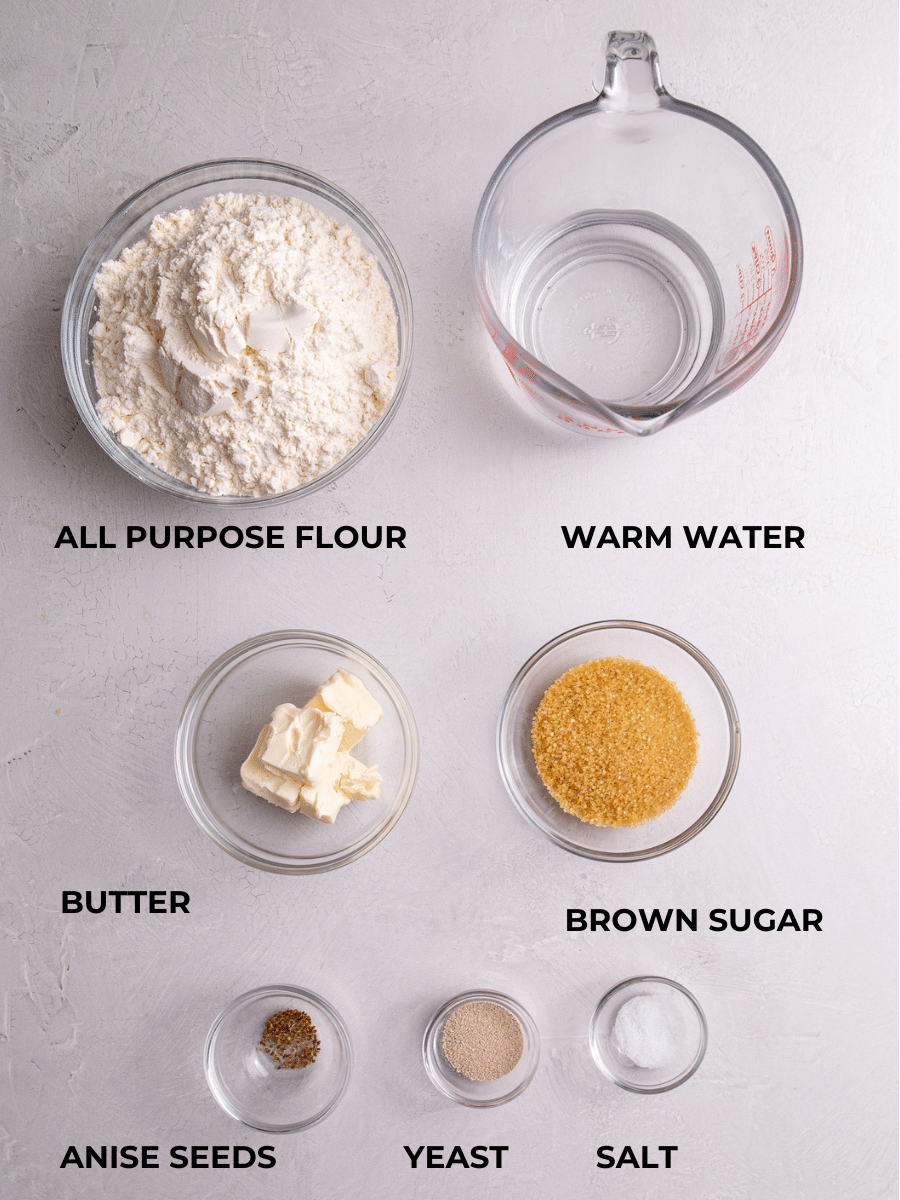
In the video below I accidentally added 1/2 cup of butter to my dough for this plait bread instead of 1/4 cup (what I typically use) but it made the bread the softest bread I’ve ever made.
- Dry active yeast: This is for texture, rise, and flavor.
- Warm water: It should be approximately 110°F.
- Brown sugar: This activates the yeast. I prefer Demarara sugar or sugar in the raw.
- All-purpose flour: For the structure of the bread, plus more for dusting.
- Salt: We use just a little to taste because too much salt will affect the rise.
- Butter: Room temperature butter is best for this recipe. It is added to the dough but also used to baste the bread once it’s done baking.
- Anise Seeds (optional): This gives the bread a sweet and slightly licorice taste.
See recipe card for quantities.
How to Make Plait Bread
Bloom the yeast
You don’t need a mixer for this simple bread. It is easy to pull together in a mixing bowl, using your hands.
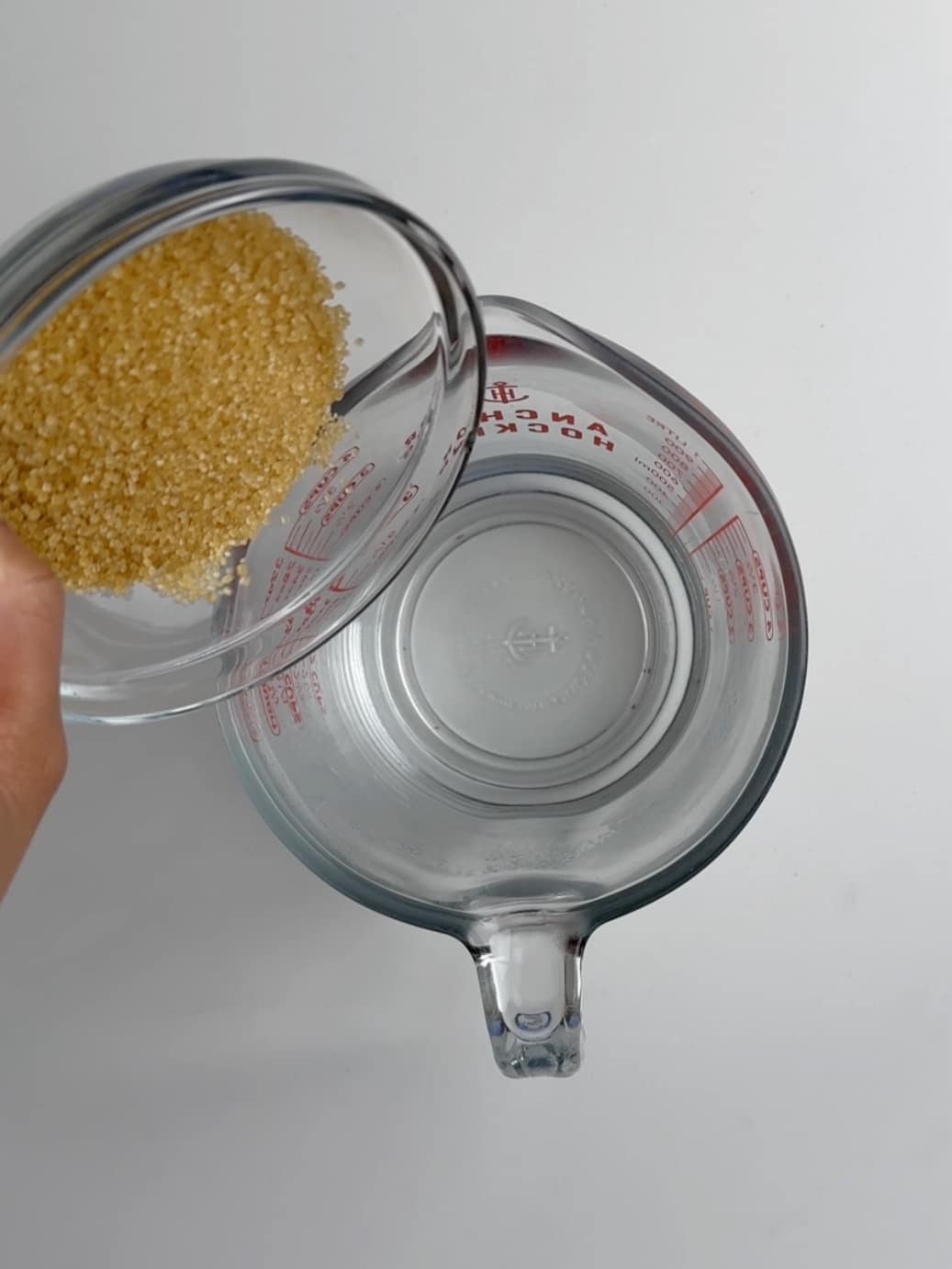
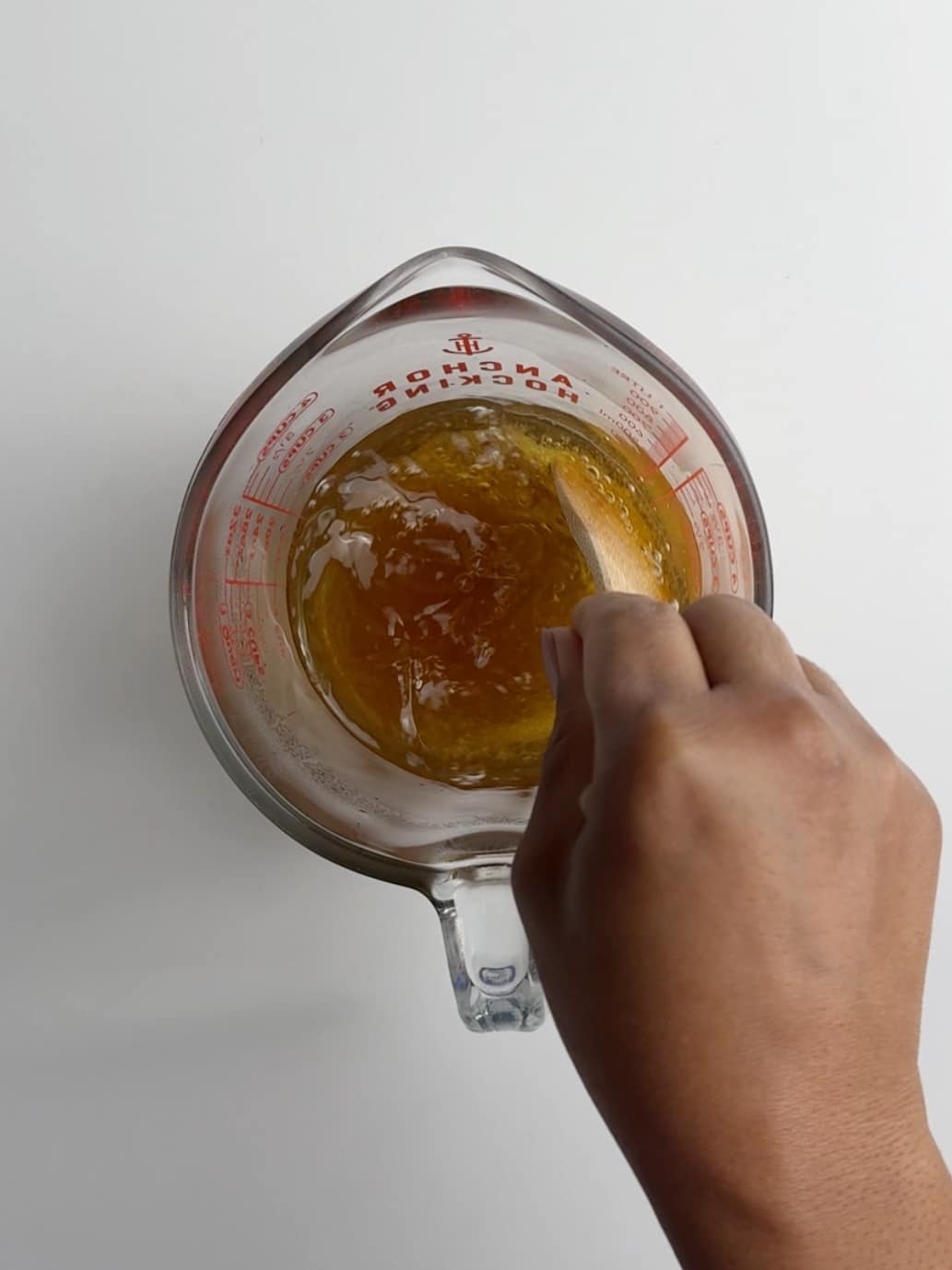
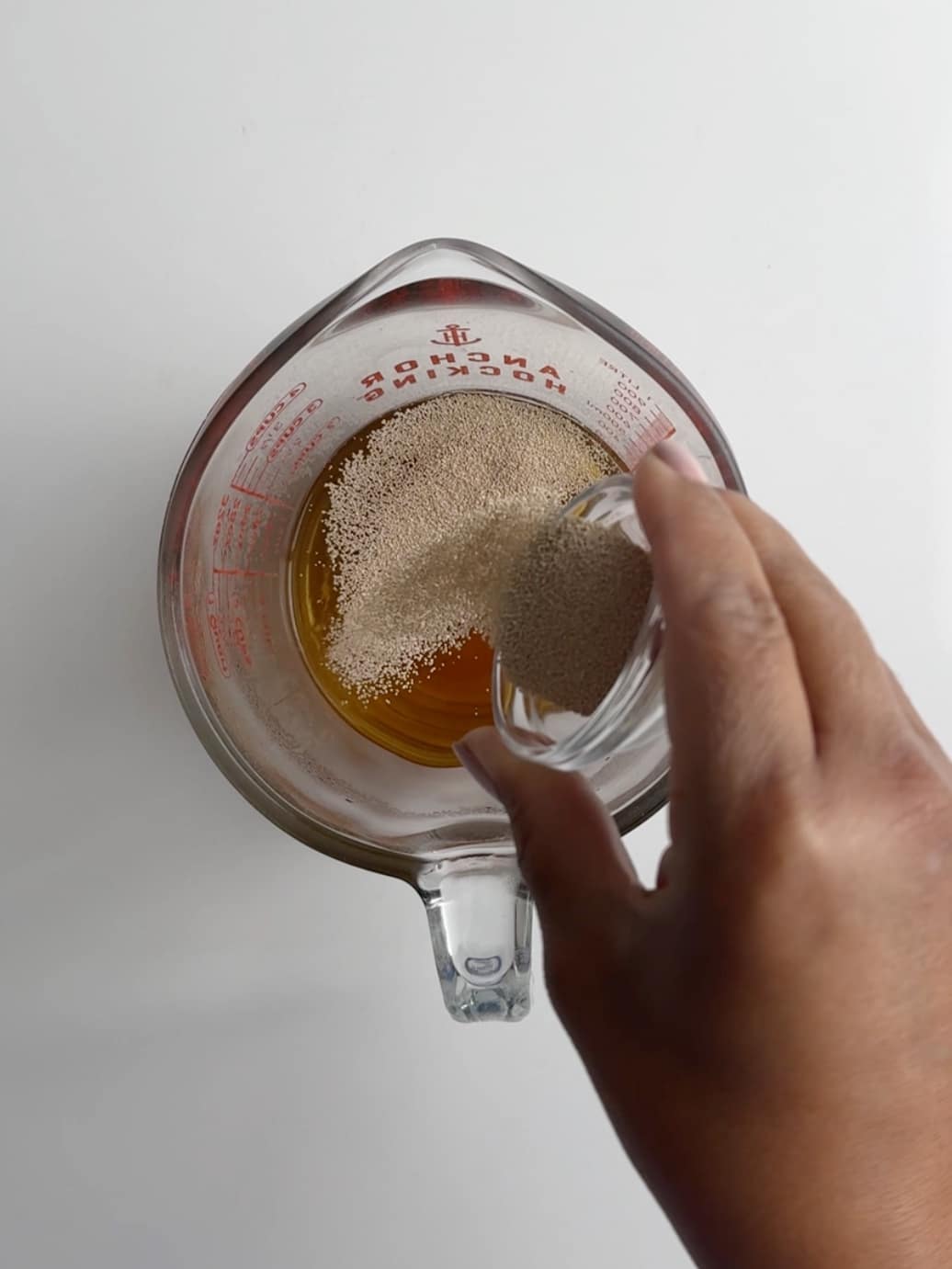
Start by blooming the yeast. Dissolve the brown sugar into warm water, then add the yeast. Cover and leave in a warm place for about 10 minutes or until the mixture has a 1 to 2 inches thick frothy top.
Make the dough
While the yeast is blooming, add the flour and salt to a large mixing bowl and mix to combine. Using a fork or your finger tips cut the room temperature butter into the flour.
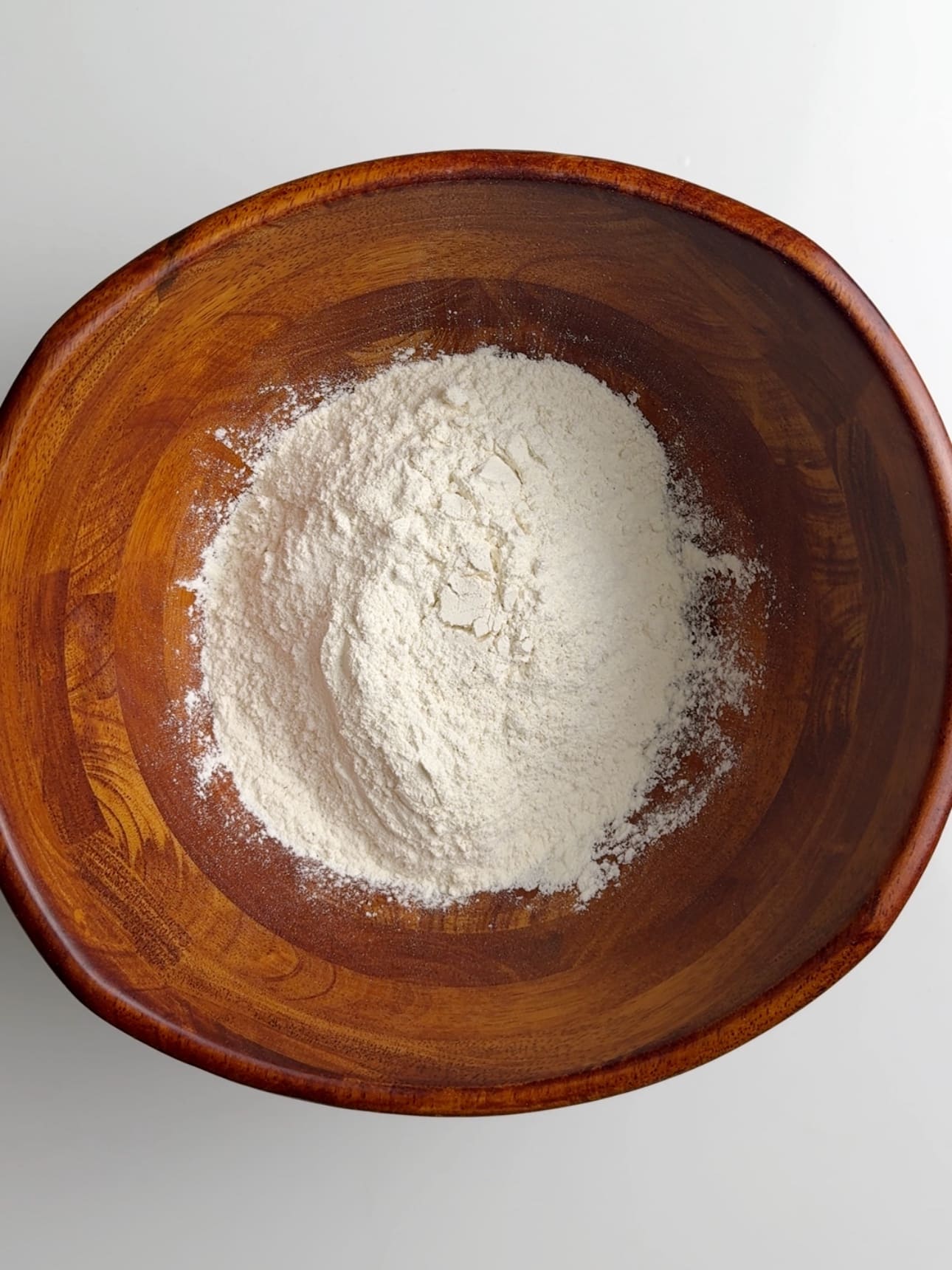
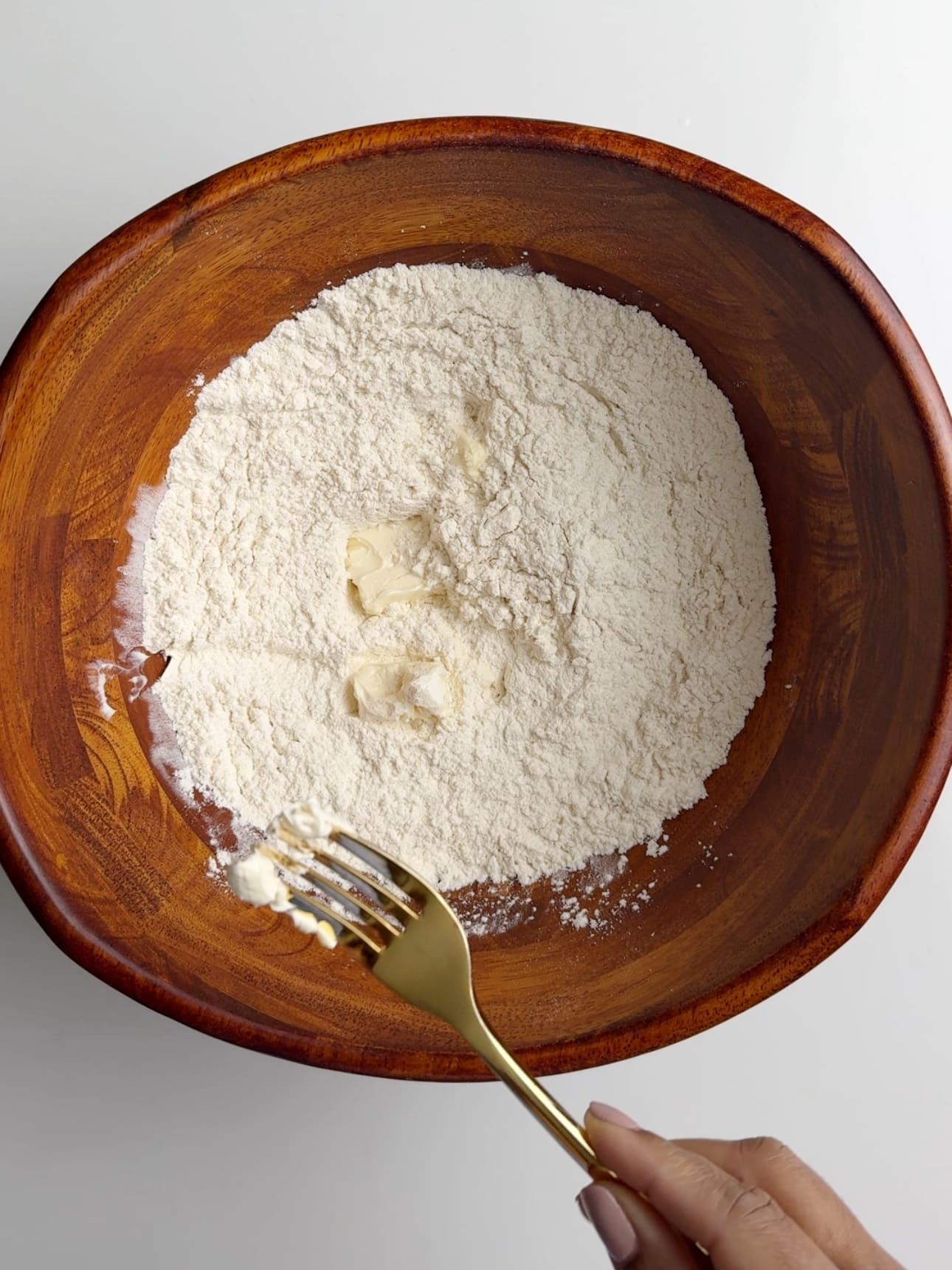
Then make a well in the center of the flour and add the bloomed yeast. Using a whisk, mix until there is a pancake like consistency.
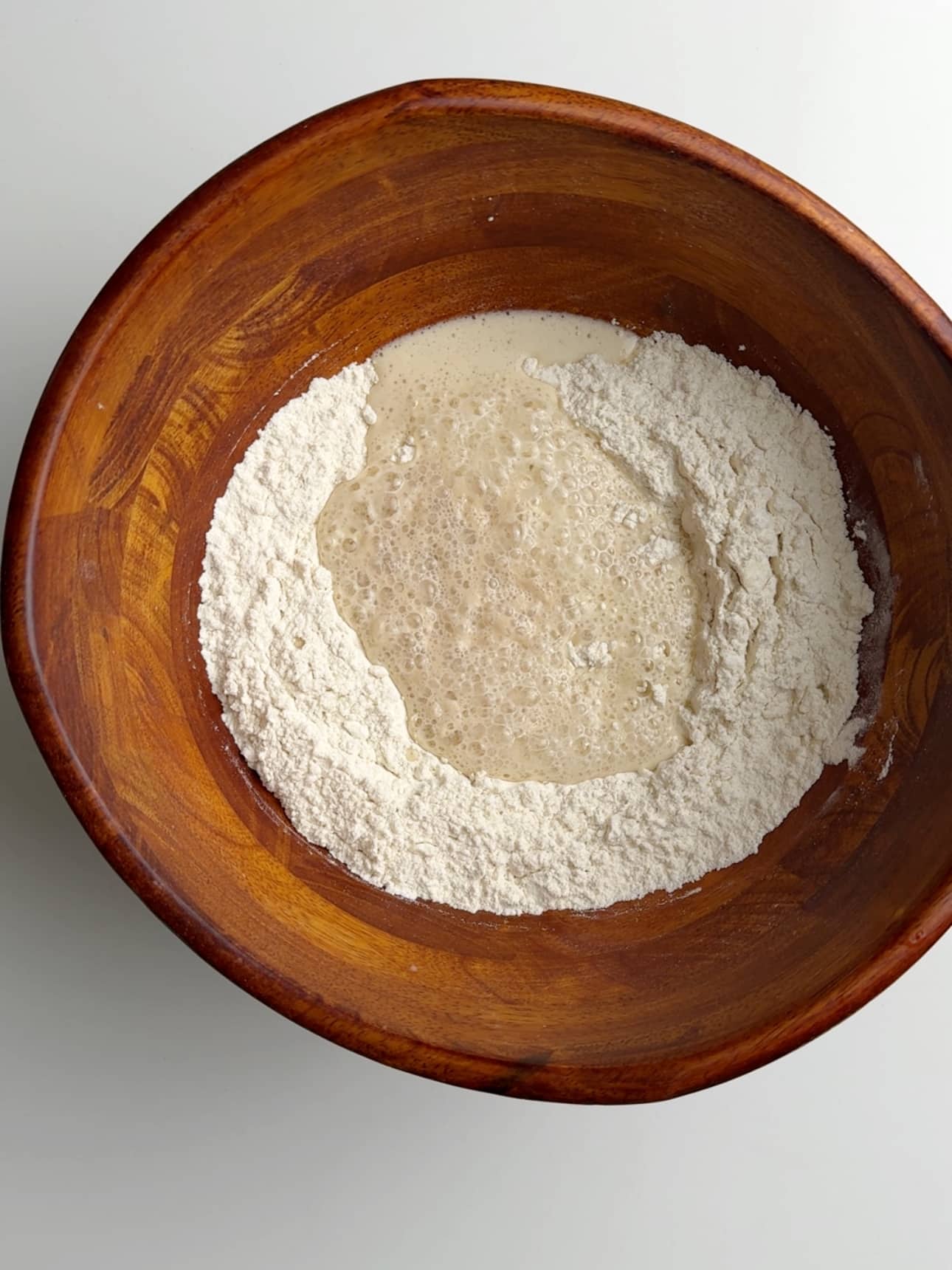
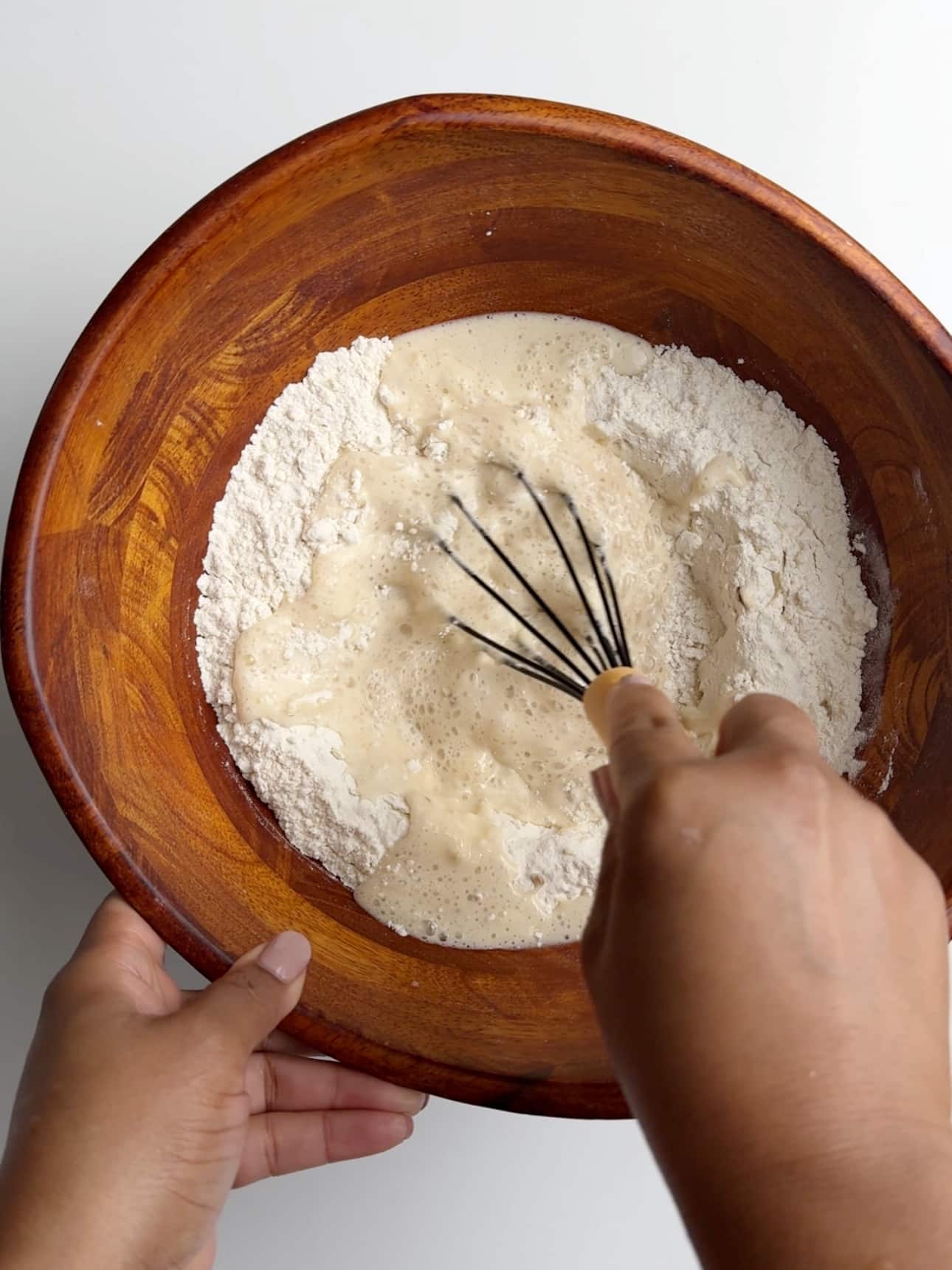

Switch to a rubber spatula or your hands and pulling flour from the edges, mix in to make a soft dough.
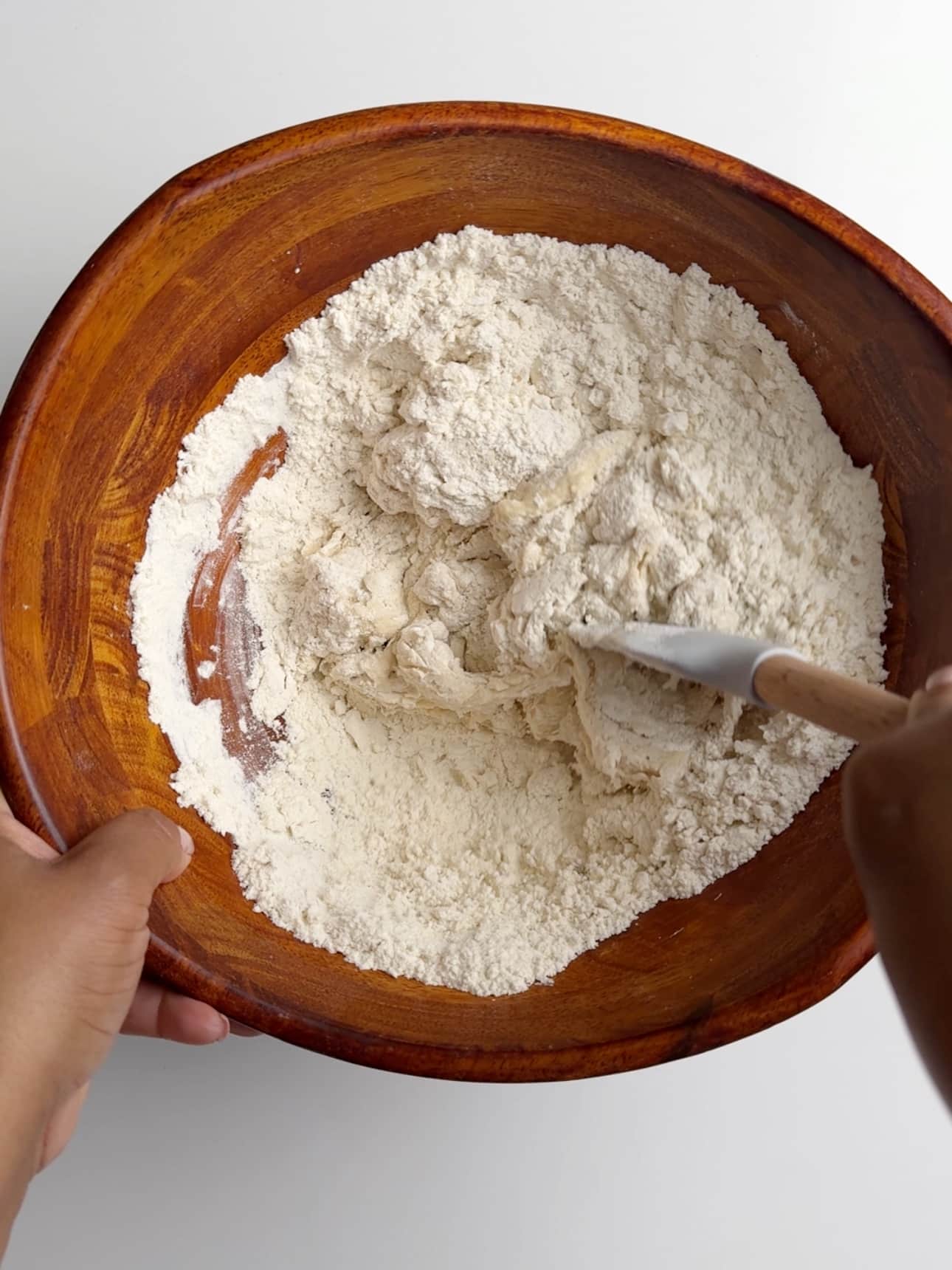

Turn the dough onto a floured surface and knead into a smooth ball or until it bounces back when touched.
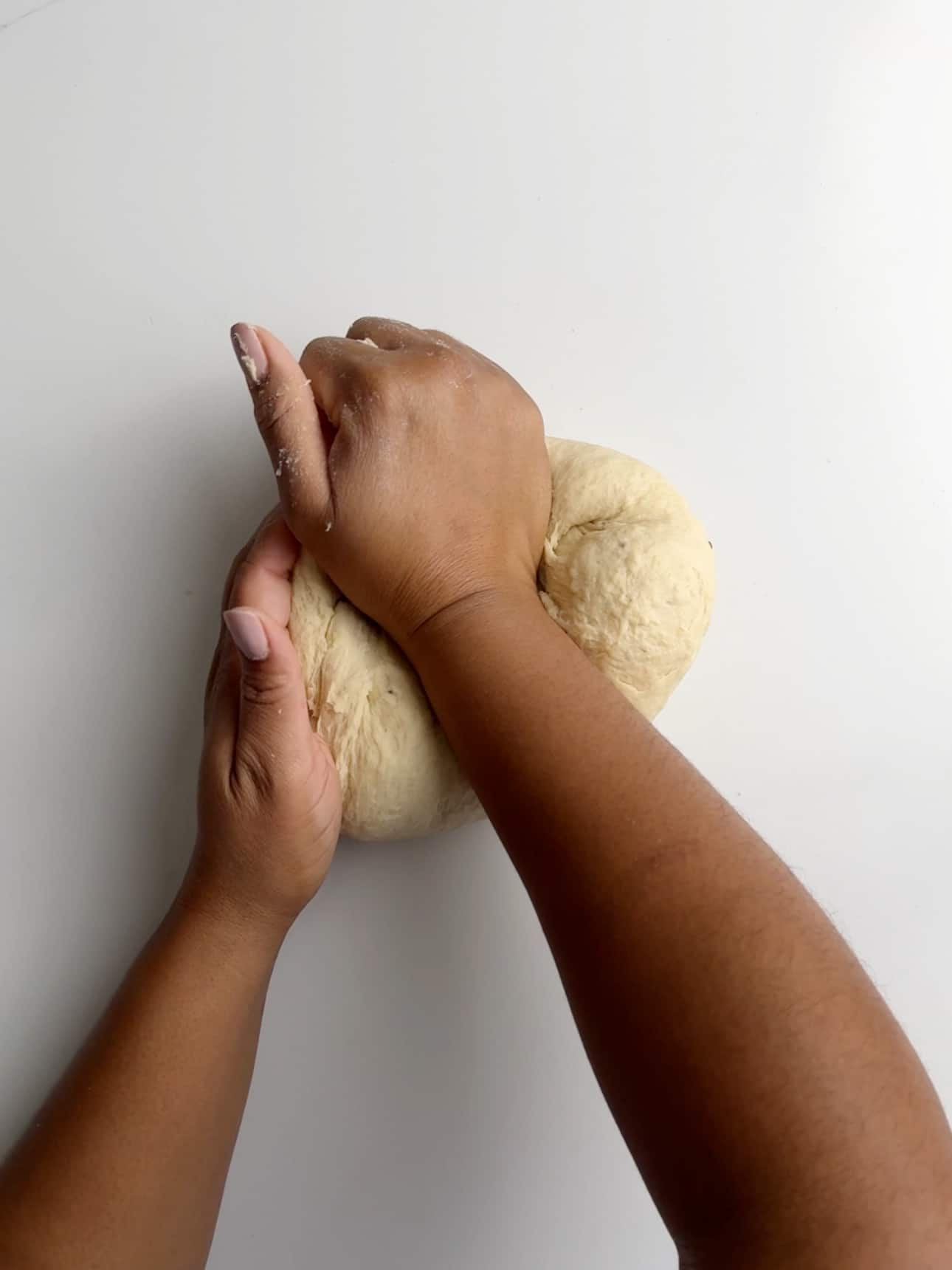
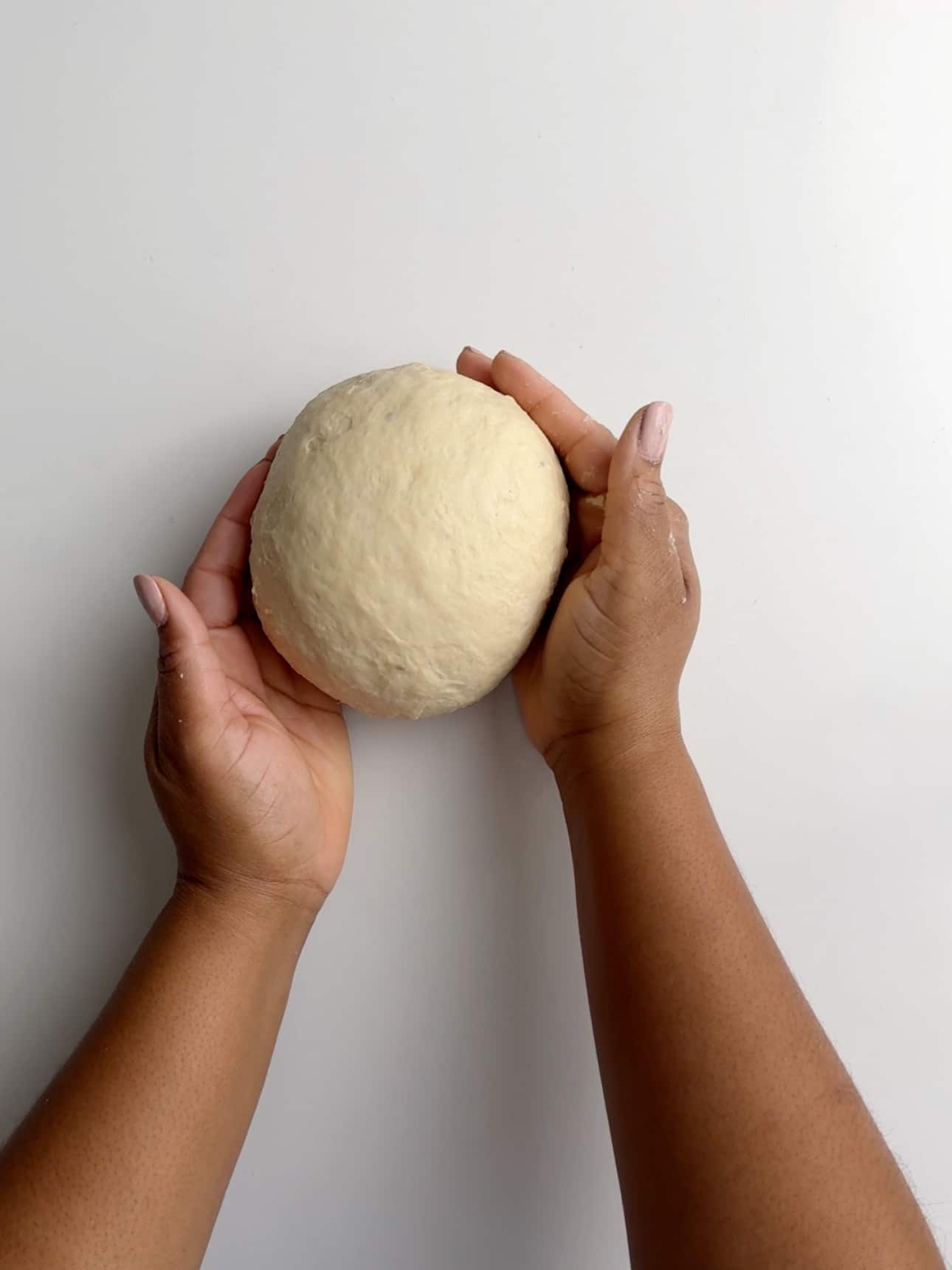
Proof the Dough for Plait Bread
For great plait bread, proof twice. During the first proof, I sometimes put my plait bread dough in a warm oven. Warm the oven up to 200 °F then turn it off. Place your kneaded dough in a greased bowl, cover and let it rest in the warm oven for 45 minutes. This gives the bread a really good rise.
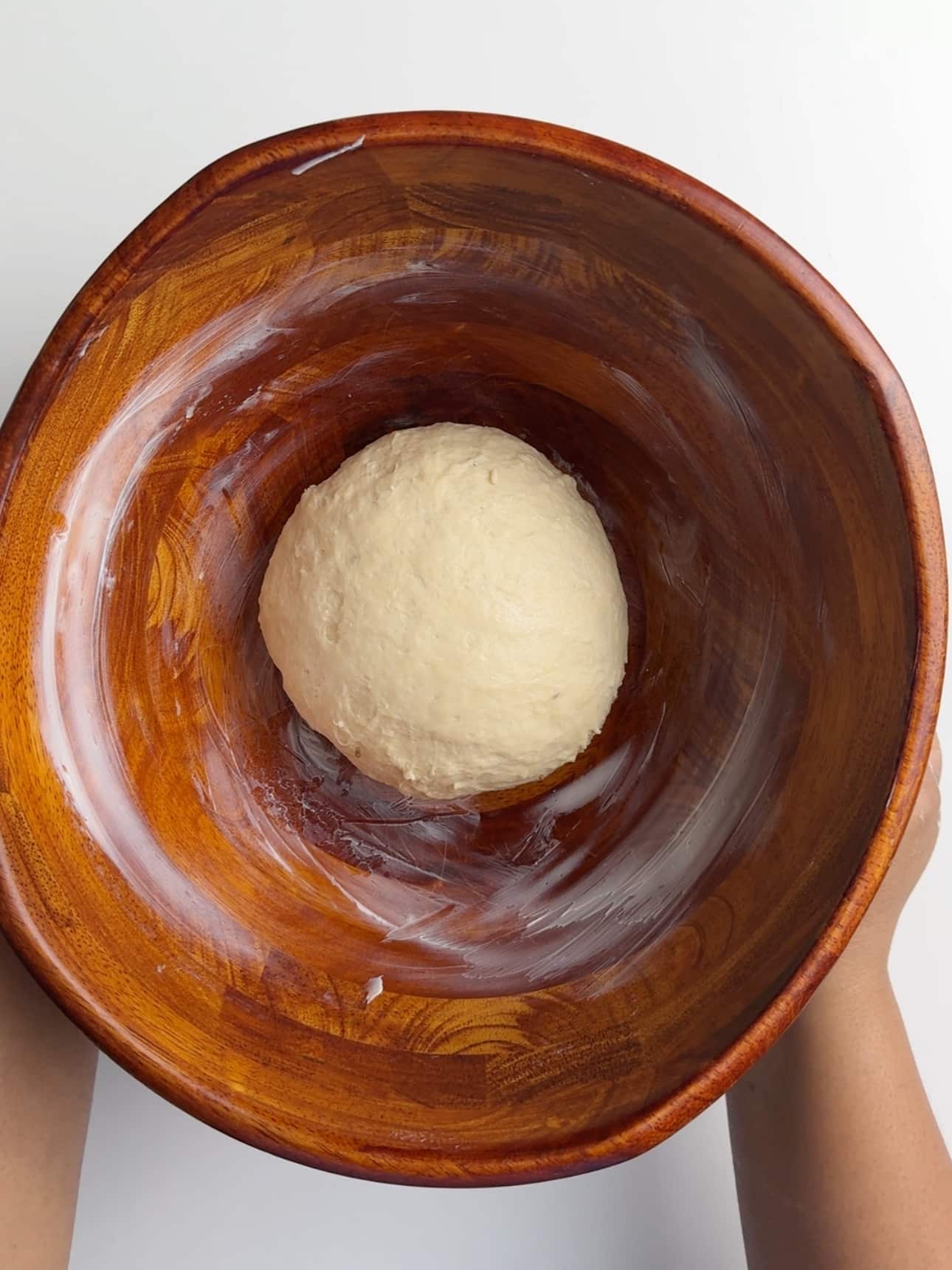
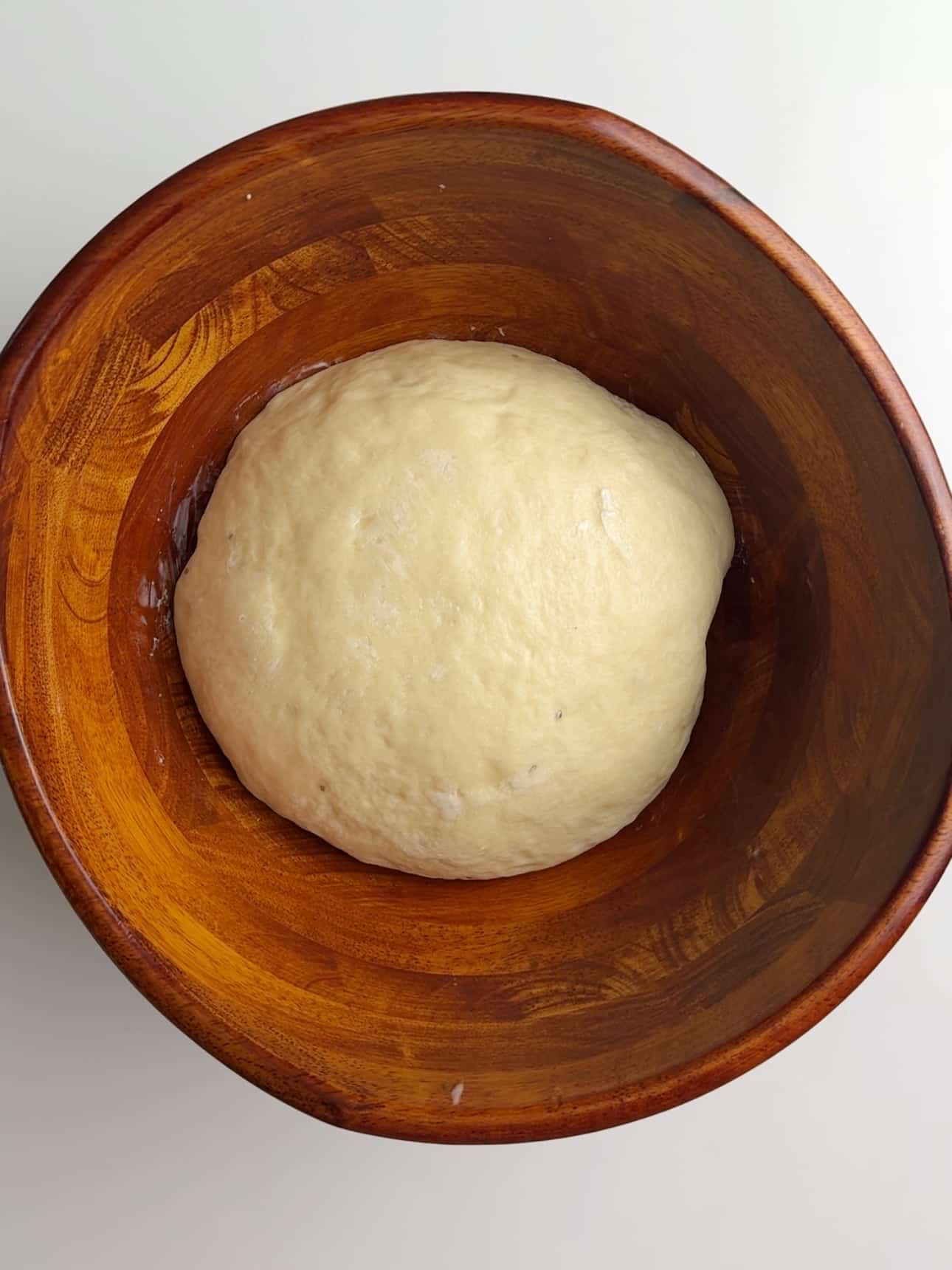
Leave the bread at room temperature for the second proof and let it proof for a full hour. This is a braided bread and any forced proofing will cause the bread to rip.
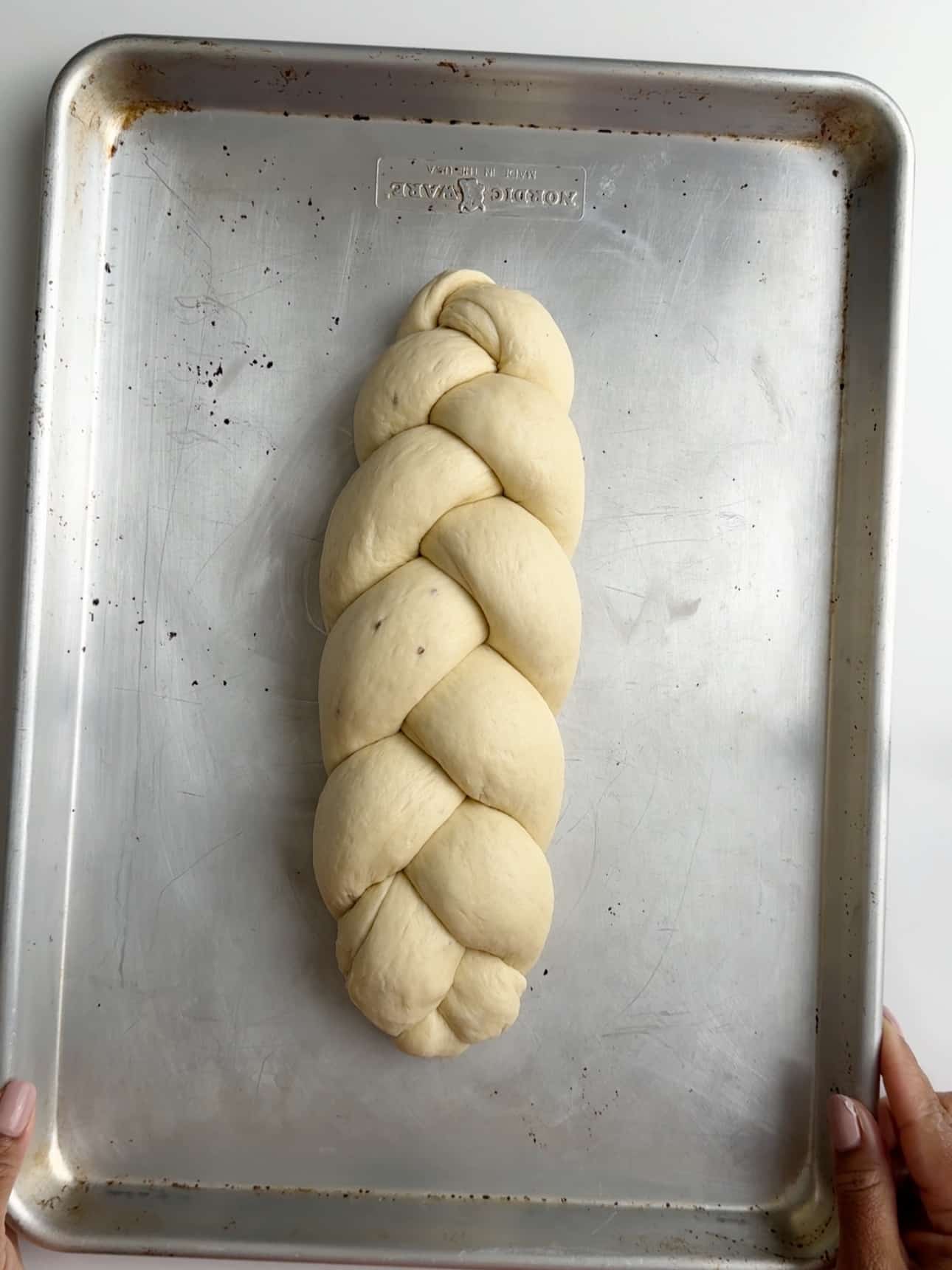
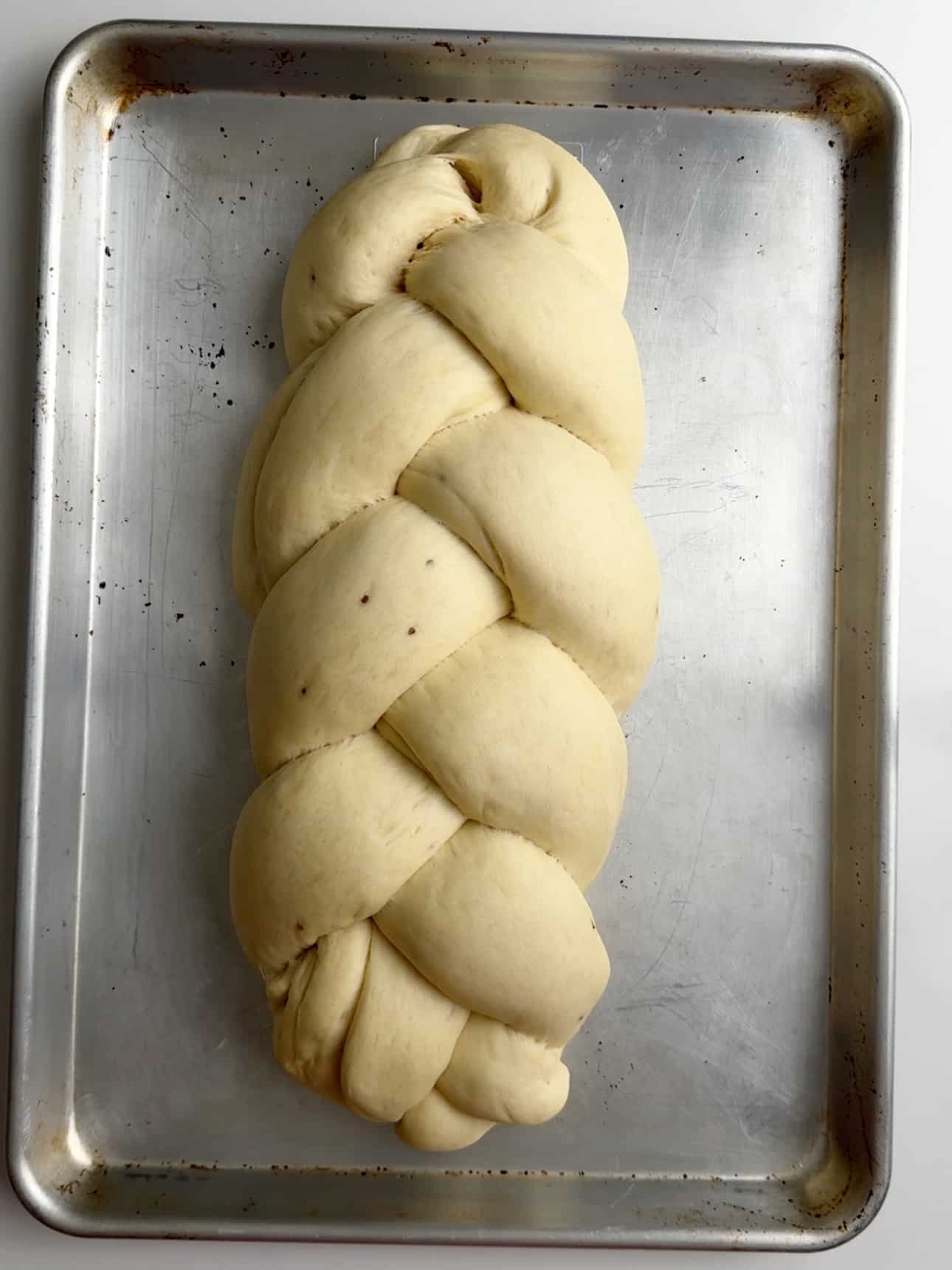
How to braid Plait Bread
Plait bread has a signature three strand braid, also called a plait in Guyana. Some people top that with a single strand, and some people leave it without. There is no right or wrong way, just depends on how your family does it.
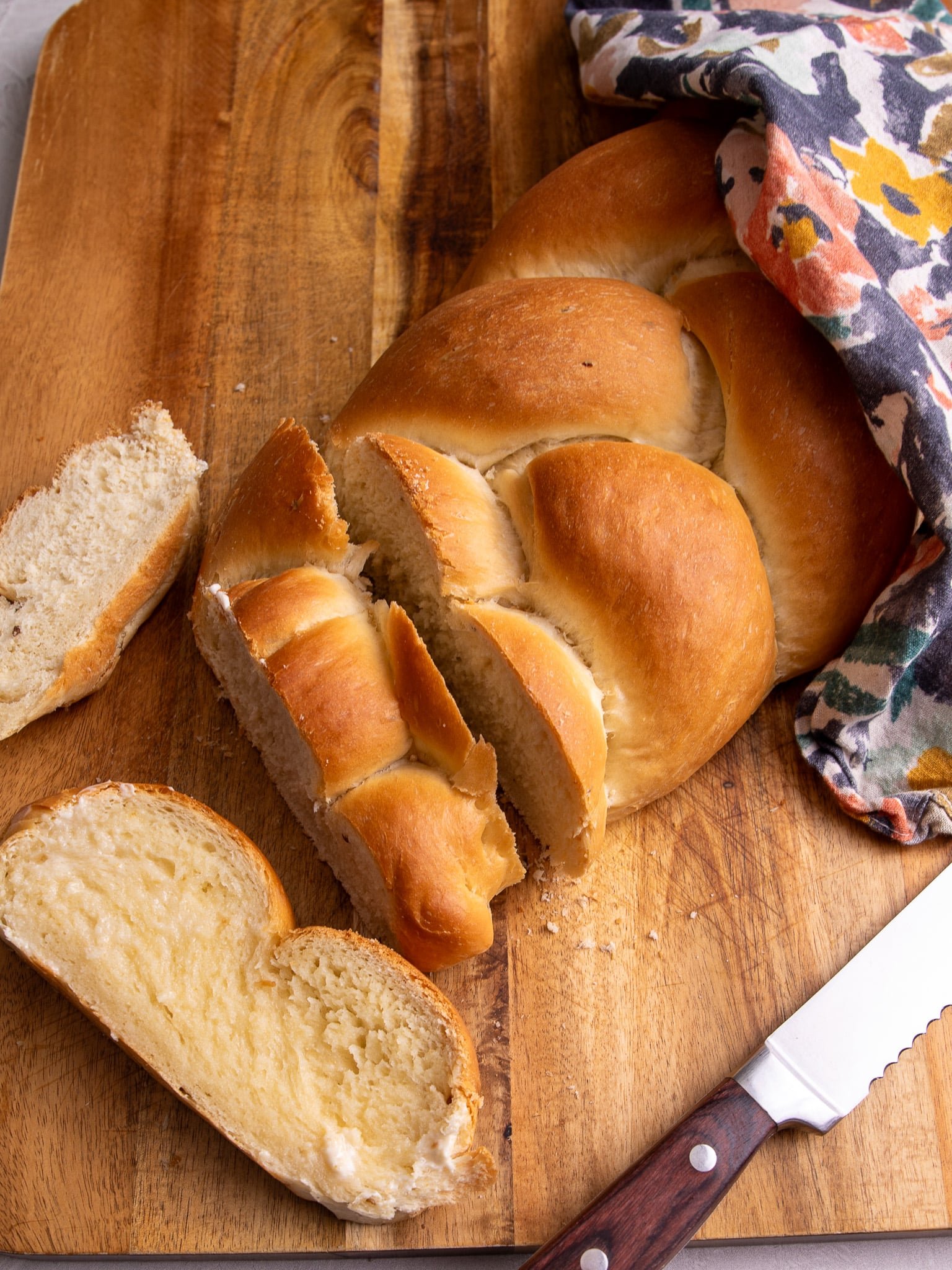
Three strand braiding
Braiding the bread takes practice but once you get the hang of it, it’s quite simple. After proofing the dough, punch down then knead into a dough ball.
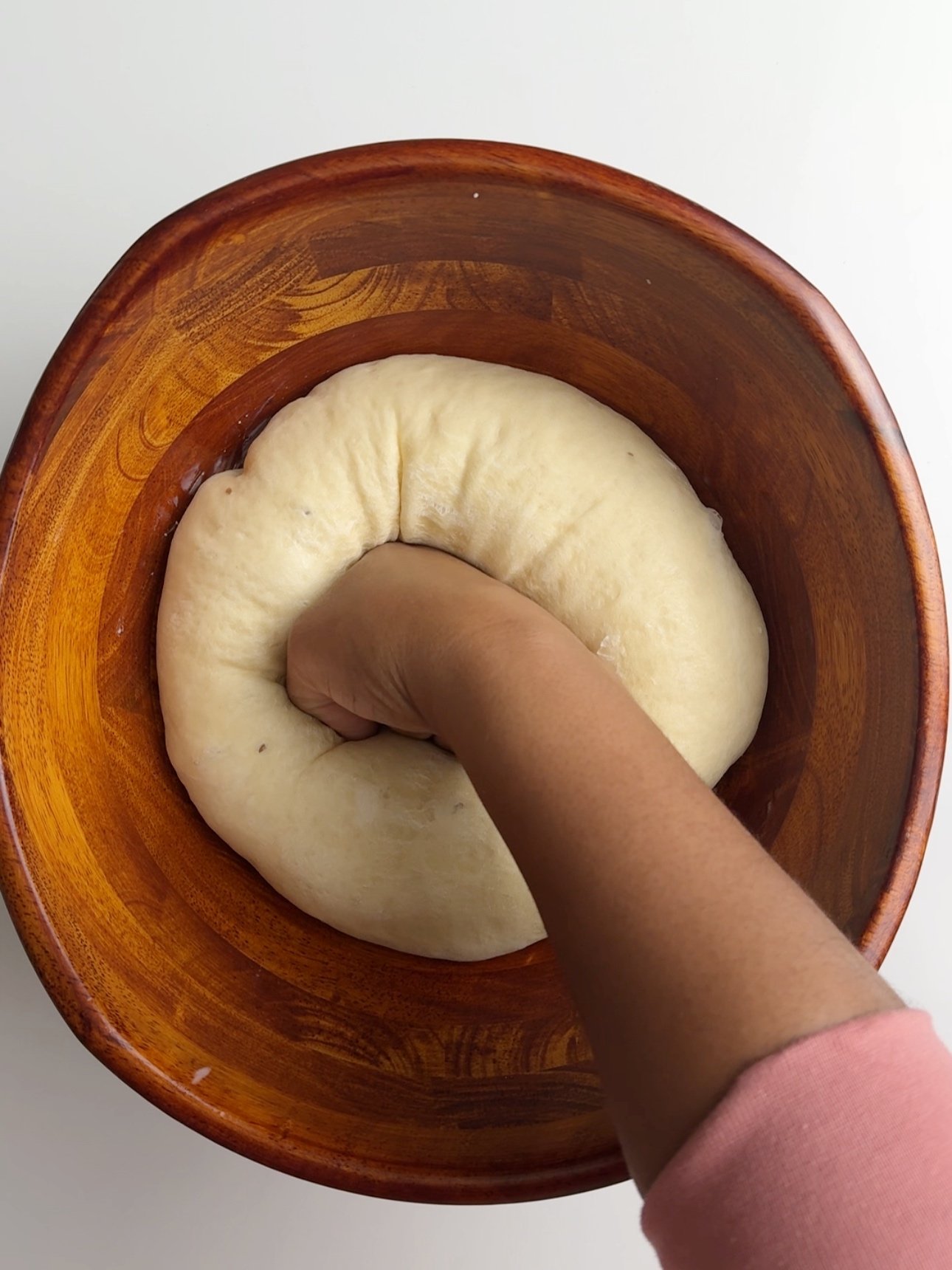
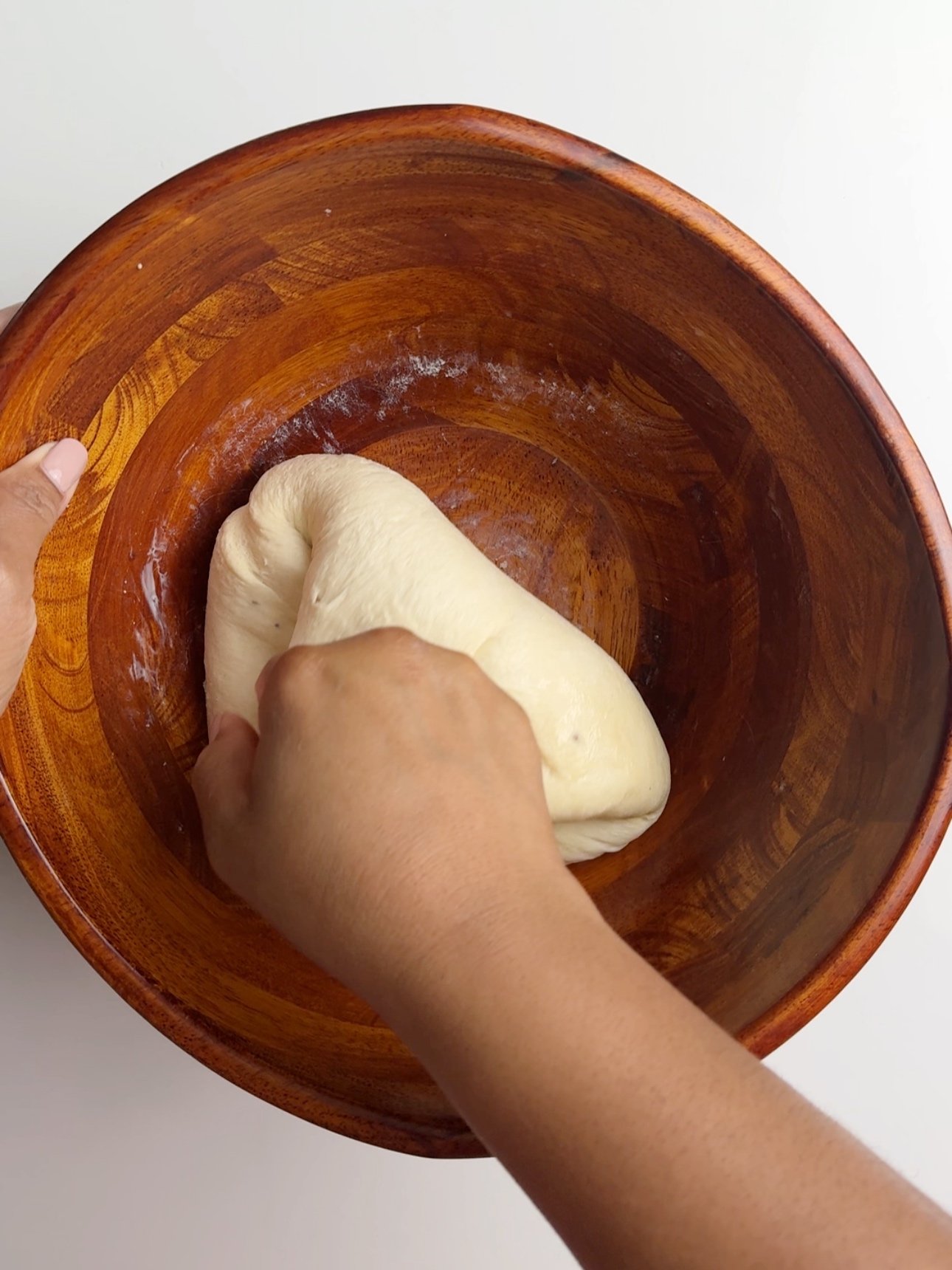
Divide the dough into three or four if you are adding a strand on the top.

Then take each of the large strands and tuck the cut ends into the back to seal it (see below). This helps to create a smooth strand.
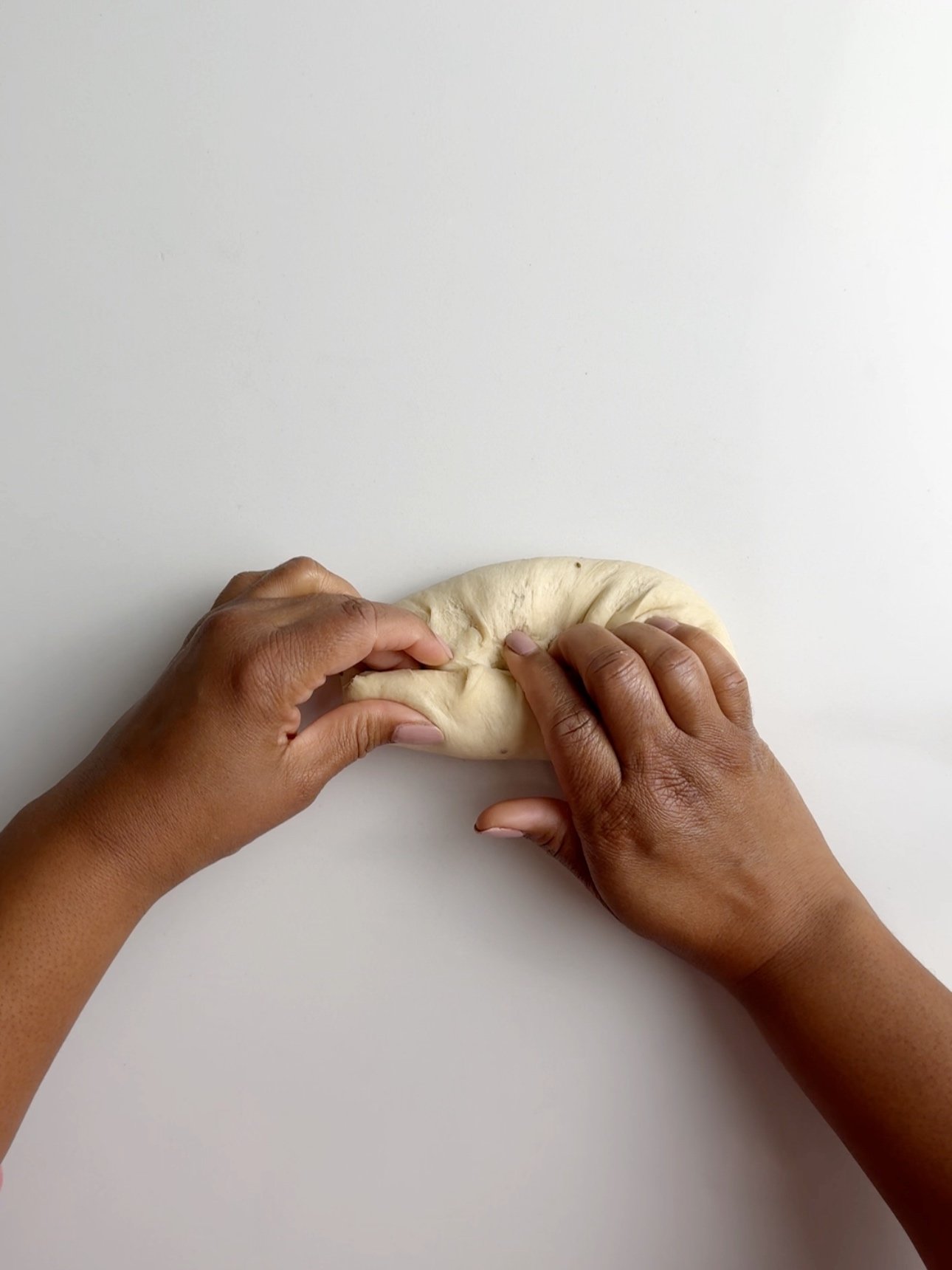
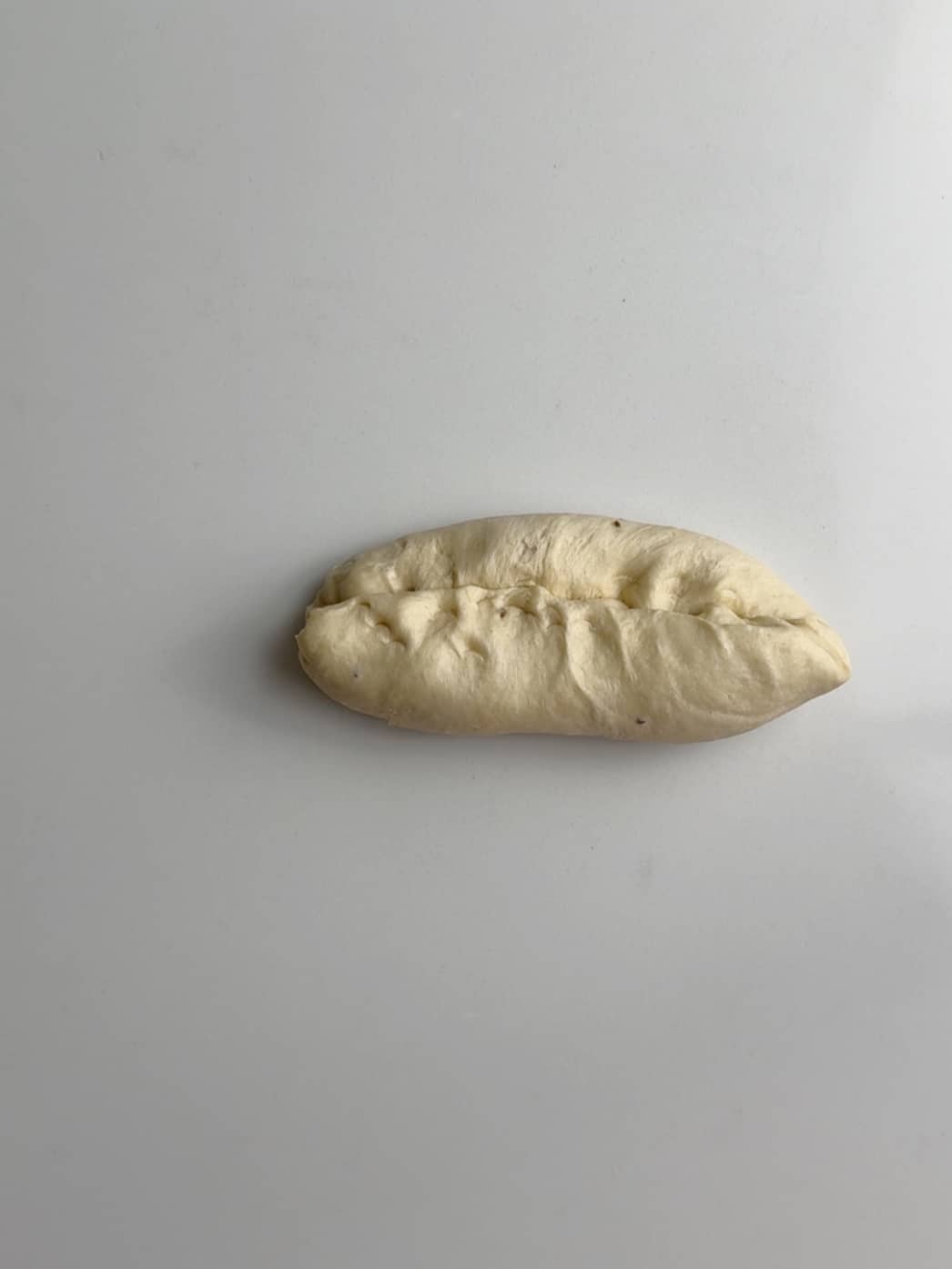
Then roll the dough into a long. Keeping the tucked in ends at the bottom and taking care to smooth out any lines or wrinkles.
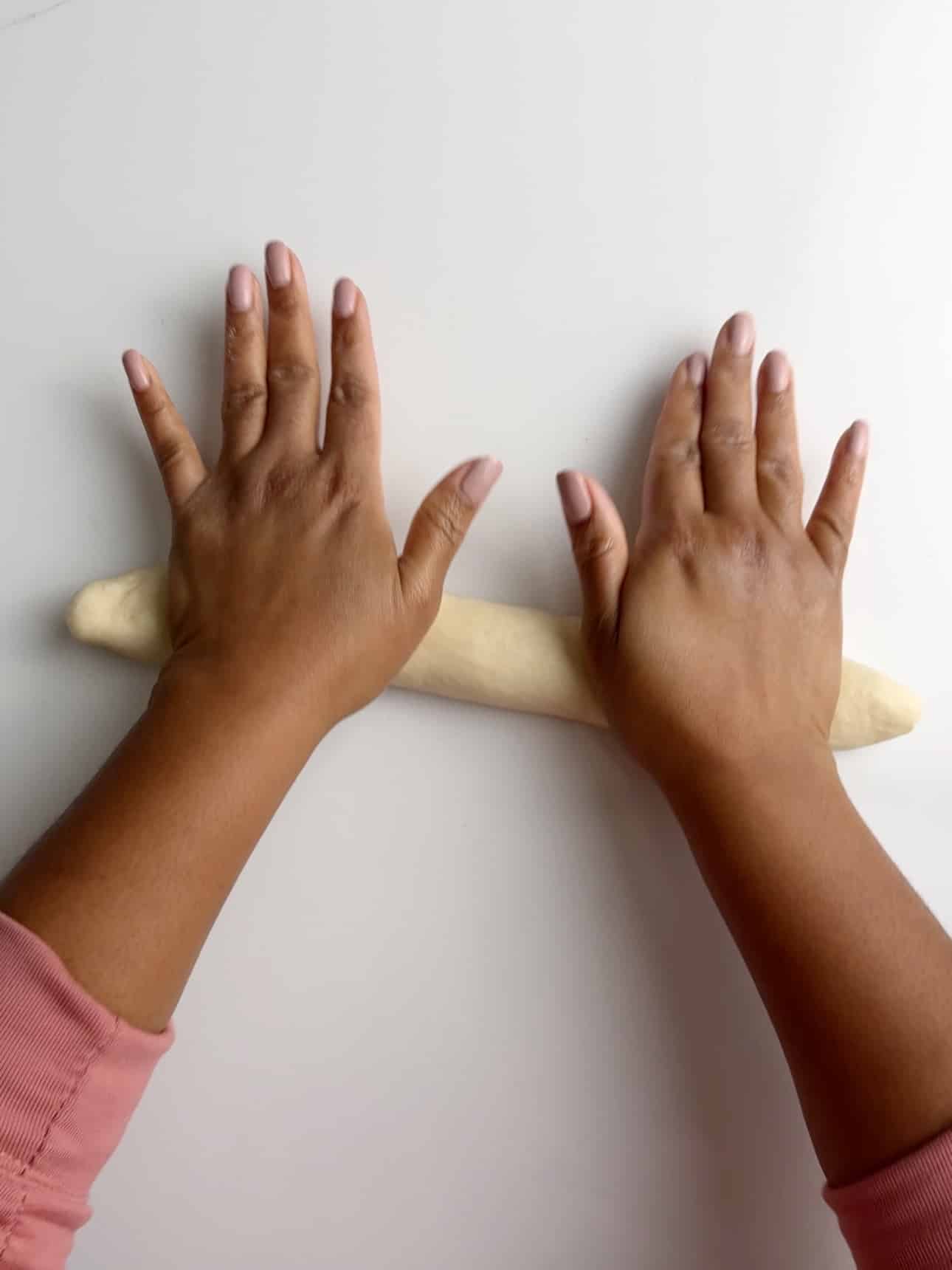
To braid plait bread place the three strands on a flat surface. Start in the middle and bring the right strand to the middle.
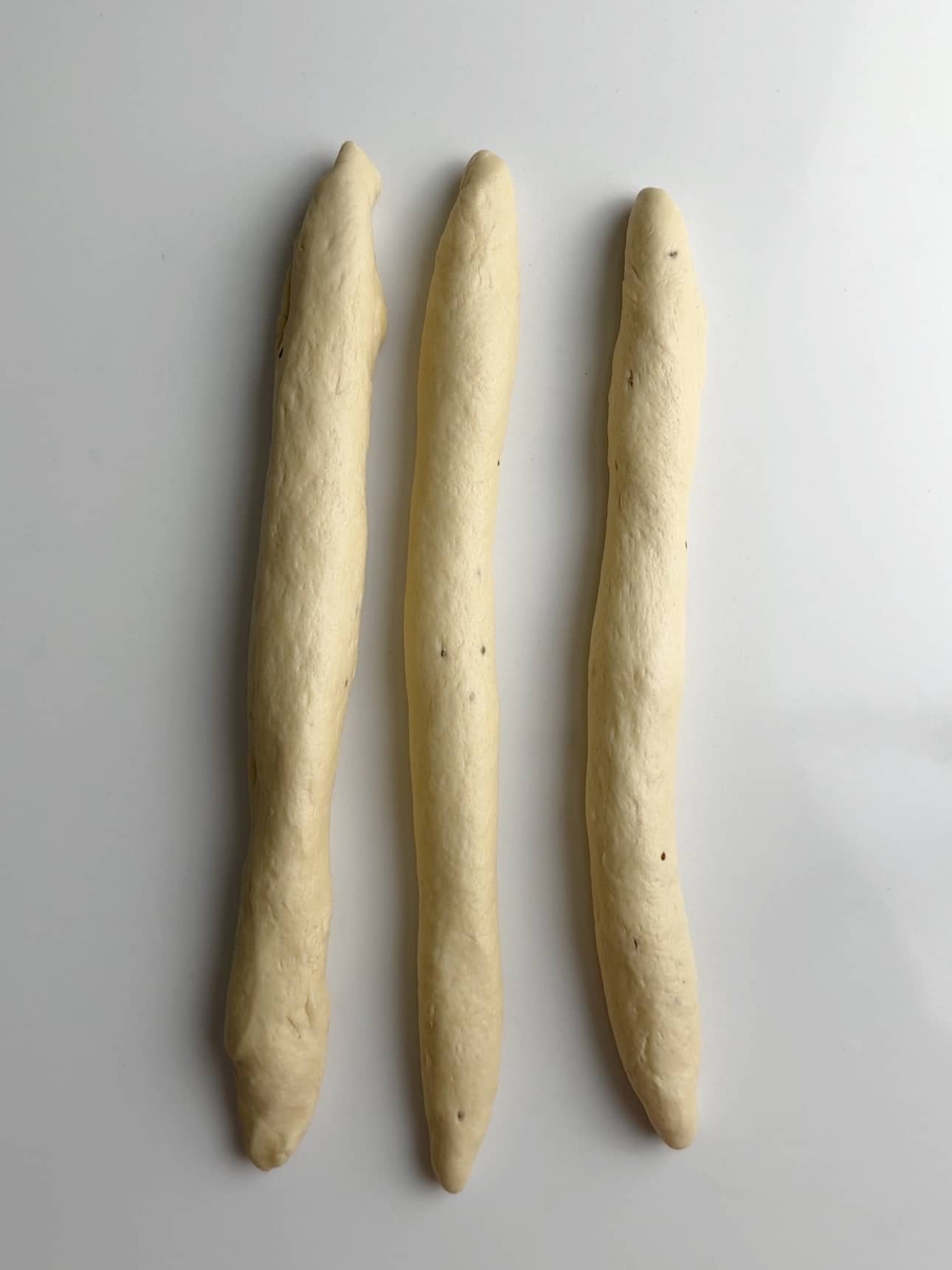
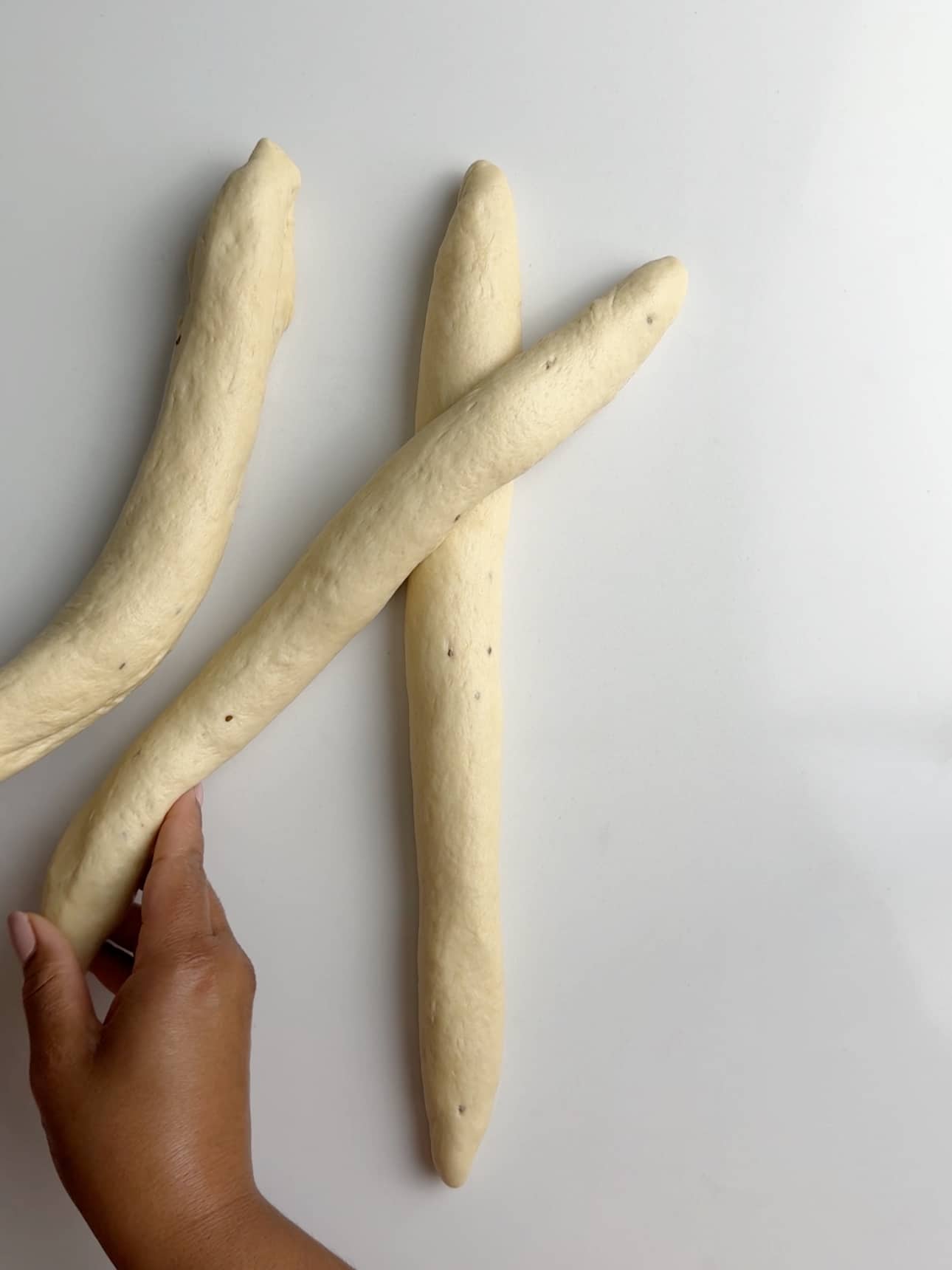
Then bring the left strand to the middle and repeat to the end.
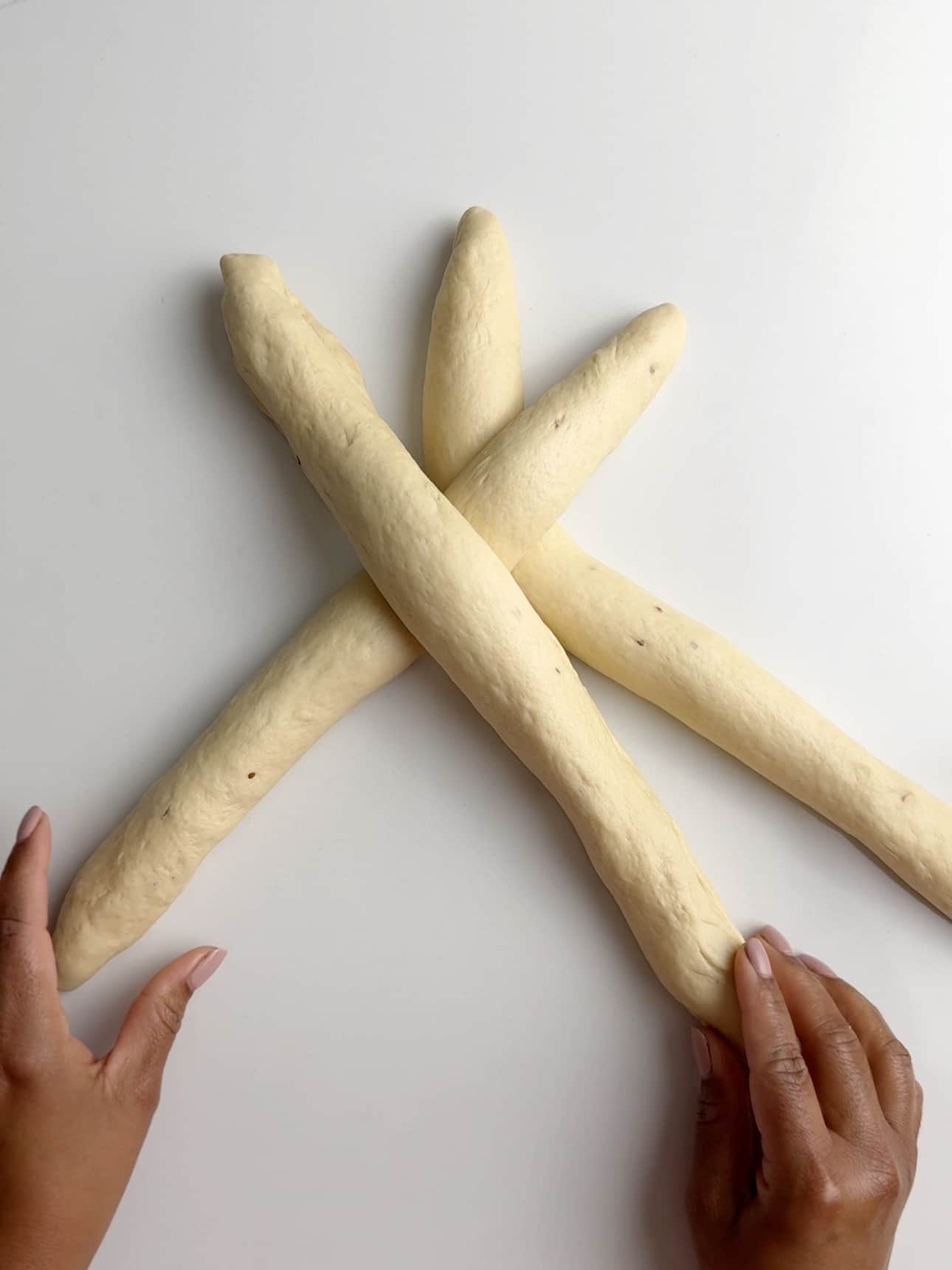
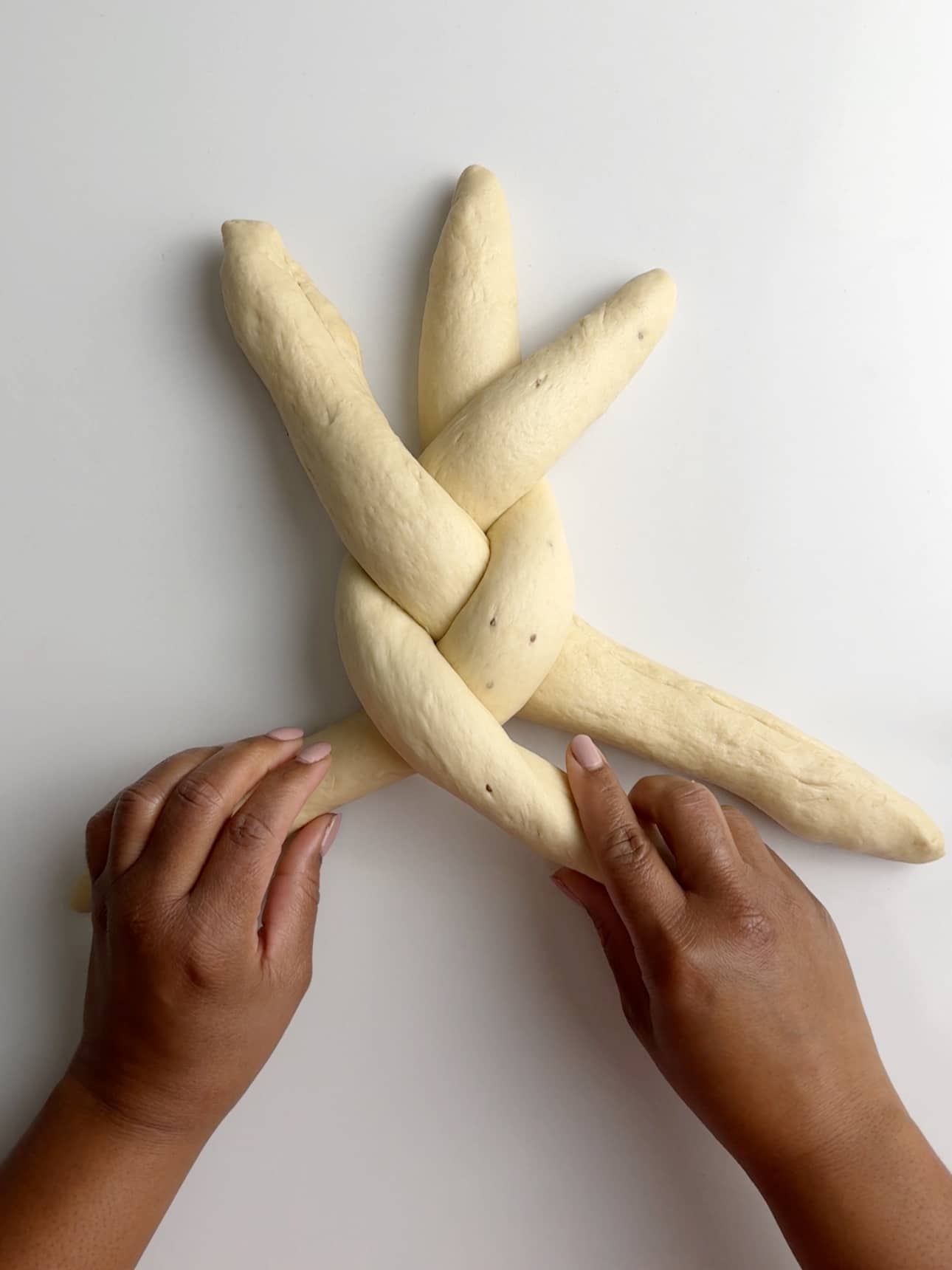
Braid all the way to the end, as far as you can go and when you get to the end tuck the ends under.

Then flip the loaf over, bring the open end towards you. And braid with the same right to center, left to center method. Go to the end, then tuck the end on top of the loaf. Remember this is now the bottom of the bread.

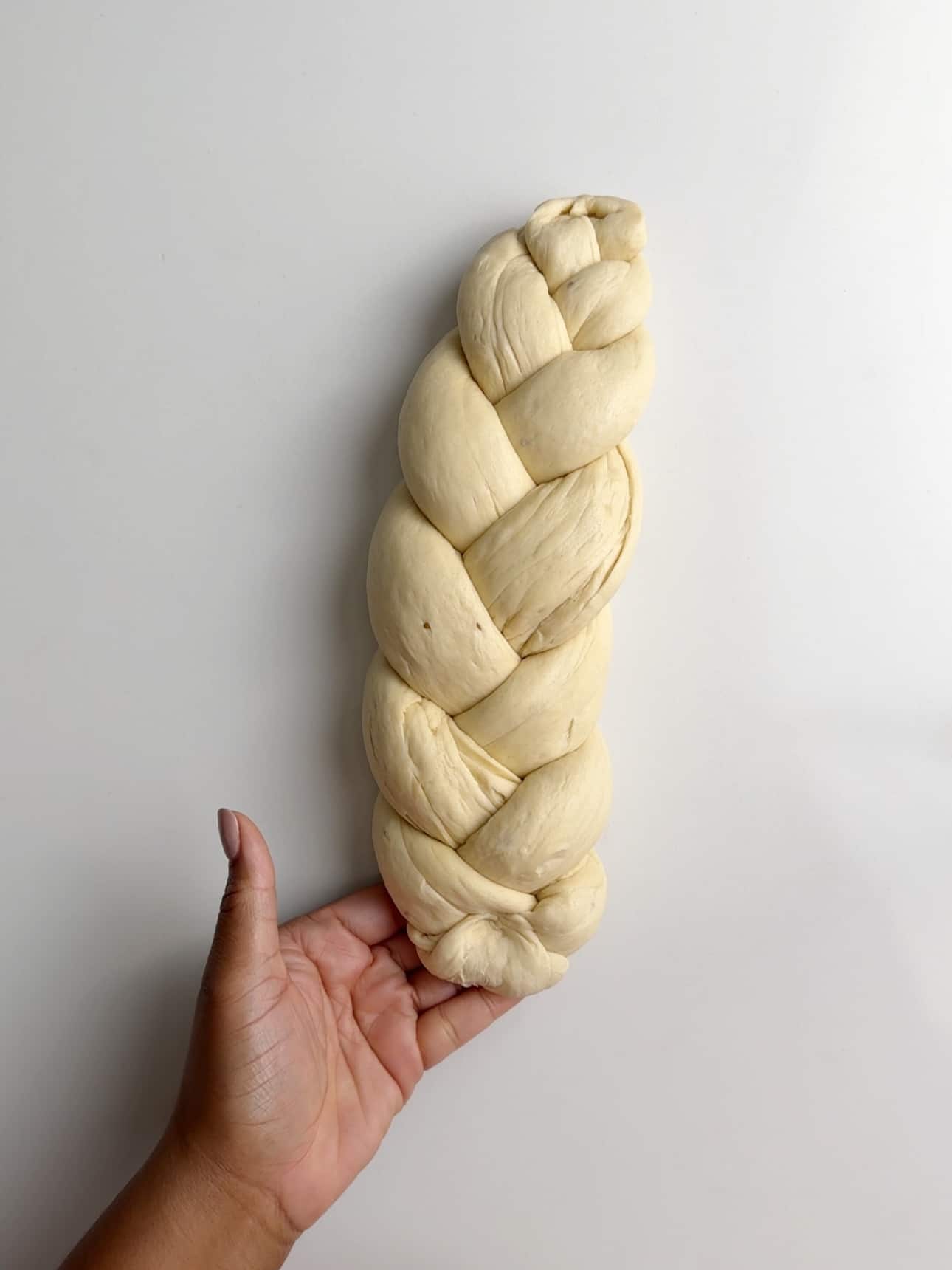
Then gently flip your braided loaf over.
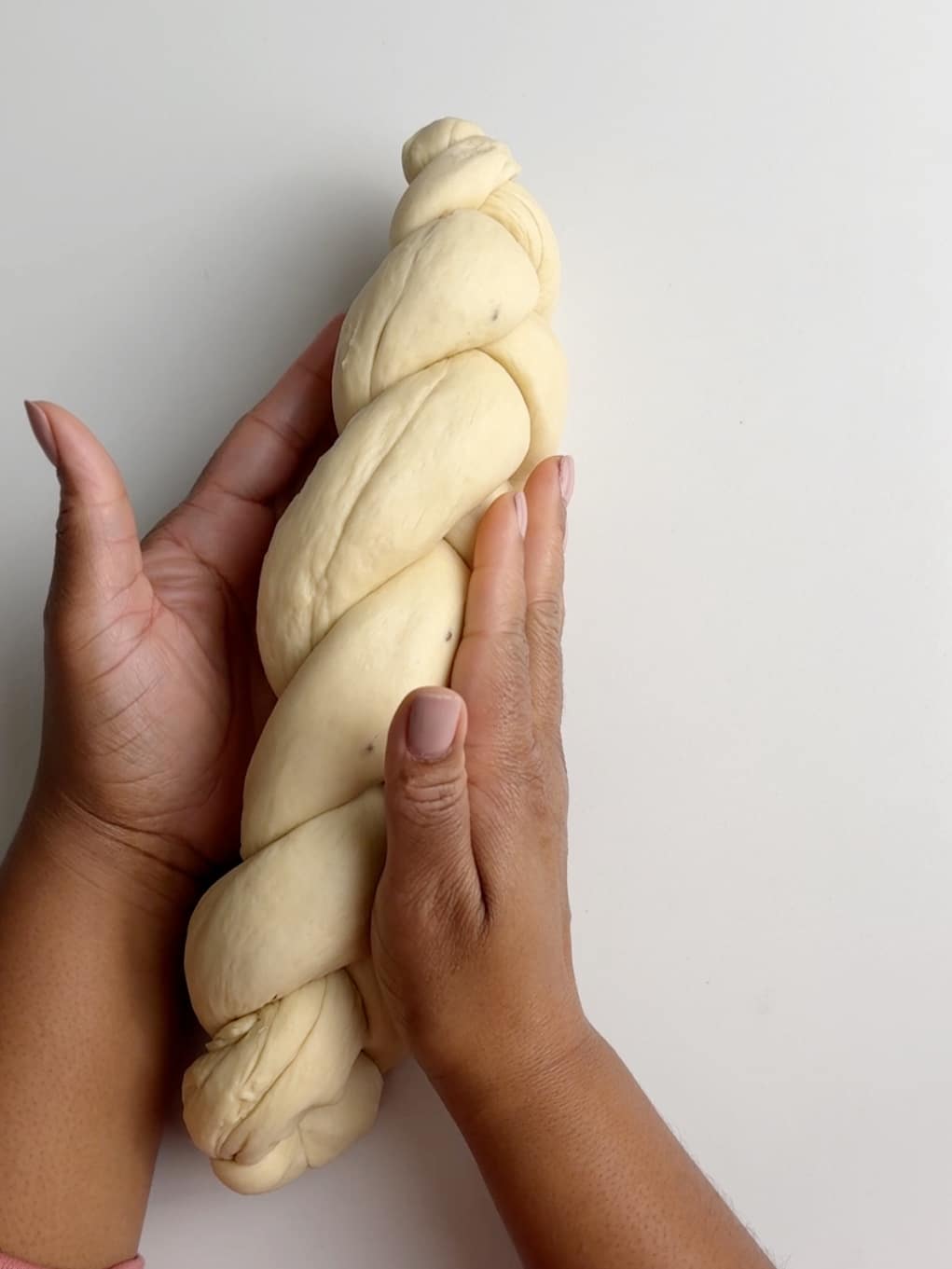
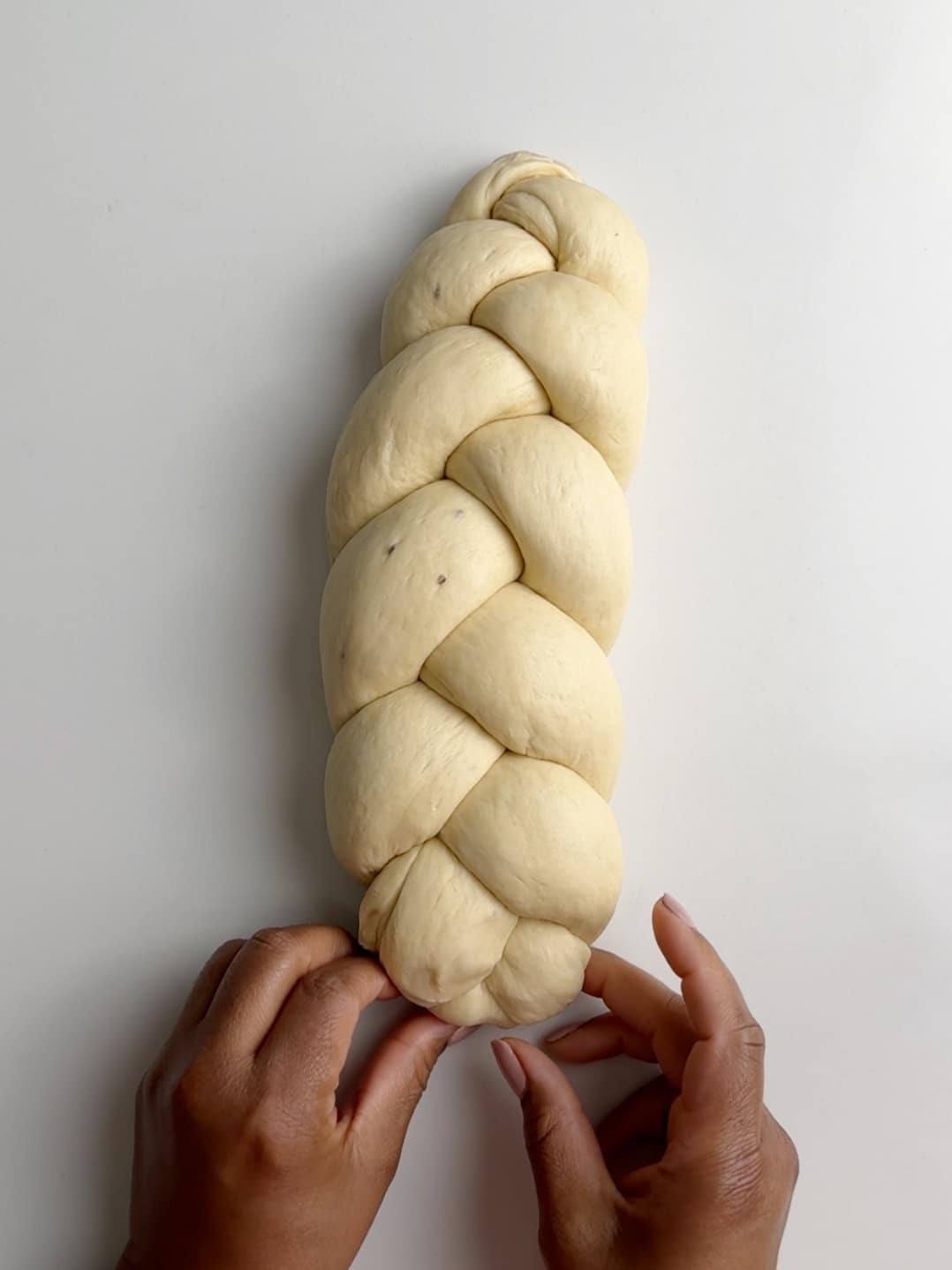
If you are adding a topper to the bread, roll out a very thing strip of dough, making sure it is long enough to add to loaf and tuck under both ends.
Baking Plait Bread
After braiding the bread, allow it to proof for an hour at room temperature. Then preheat your oven to 350°F. Bake the bread for 25 minutes. Then rub with butter, immediately after you take it out of the oven and move to a cooling rack. Cover the bread with a clean kitchen towel while it cools to prevent it from drying out.

The Step by Step Video Tutorial
Substitutions & Variations
- Aniseed (Anise Seed) Bread: A lot of Guyanese people love to add anise seeds to their bread. See below for how to incorporate anise seeds to your bread.
- Vegan. Make this Guyanese bread vegan by using vegan butter.
- Sugar. You can use white granulated sugar instead of brown sugar but I prefer the taste of Demerara sugar or sugar in the raw in this recipe.
- Same Recipe without Plaits. If you are not a fan of plait bread, use this recipe to make two loaves of bread instead. After the first rise, punch down and knead the dough into a ball, then divide the dough ball in half and roll into two logs. Place on a greased baking sheet or in two loaf pans and let the dough rise again before baking.
- Wholewheat Plait Bread. If you prefer wholewheat bread try this Guyanese Style Wholewheat Plait Bread recipe. It is an oldie but yields delicious results.
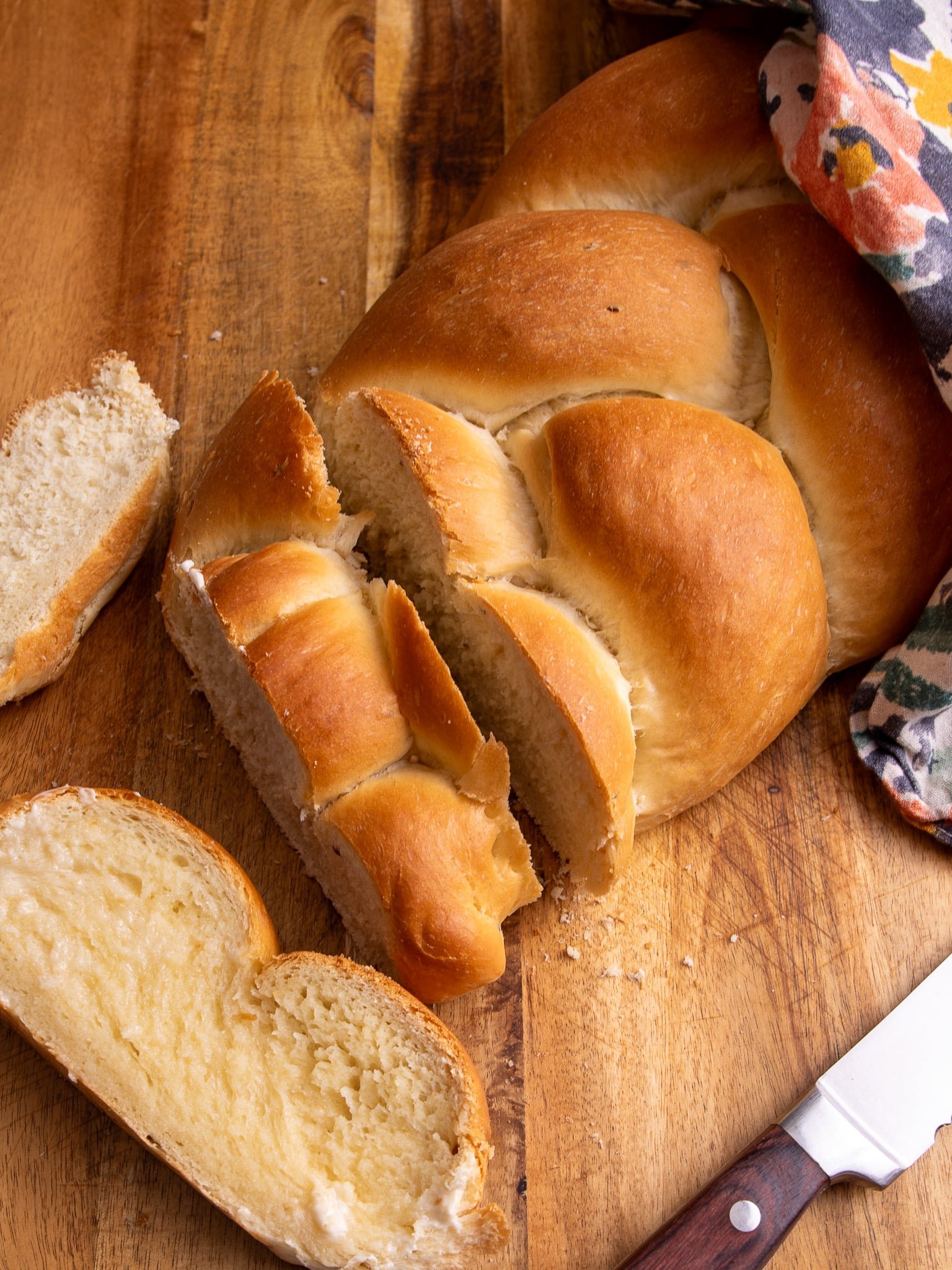
Guyanese Aniseed (Anise seed) Bread
To make Guyanese Aniseed Bread add 1 teaspoon of anise seeds to 1 1/4 cups of boiling water and allow to sit until the water cools down (about 110°F). Then follow the steps for making plait bread dough, using this water to bloom the yeast.
Equipment
- Whisk: This is used to combine wet ingredients and dry ingredients.
- Rubber Spatula: To scape the bowl and incorporate all the ingredients.
- Mixing Bowl: To contain the dough.
- Baking Sheet: For baking the plaited bread.
Storage
After the bread has completely cooled, place the loaf in a plastic bread bag to keep it soft and fresh. If you don’t have a bread bag you can wrap it with a clean kitchen towel to keep it from drying out.
Store it in a cool dry place for 2-3 days. Placing it in the fridge can make it stale prematurely.
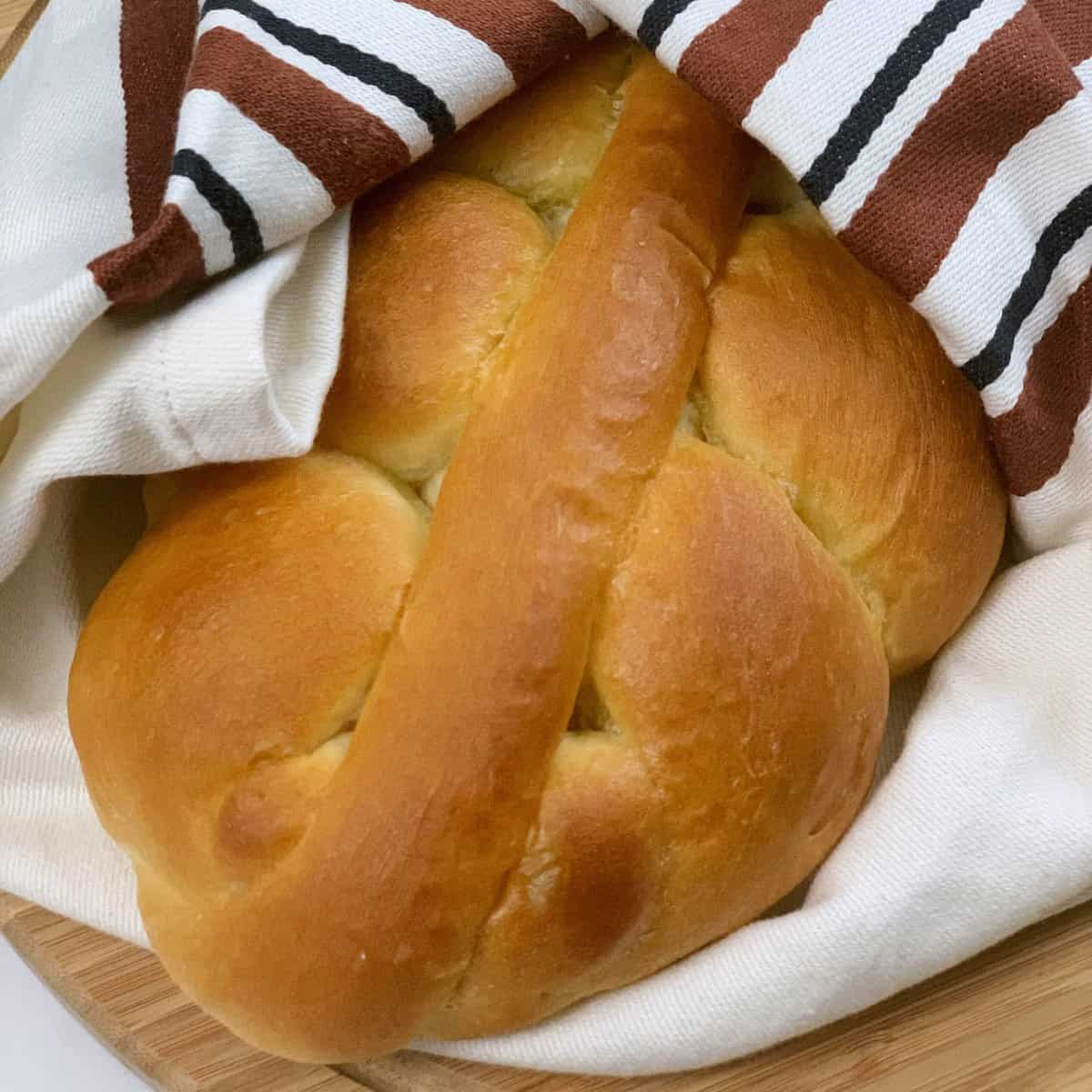
Tips for the Best Plait Bread
- Have patience. This is not a quick bread. It needs time to rise, punch down and rise again before baking. But it is absolutely worth it!
- This bread is perfect for French toast (if it lasts long enough to get stale) or tawa toast: toasting it on a hot skillet with butter!
- To speed up the dough rising process, place covered dough in a warm oven (turn oven on to 200°F for 10 minutes, then shut it off). This is great to speed up the first proof, but should not be used for the second proof or your plait will rip apart.
- For best results let the second proof happen at room temperature and let it proof for the full hour.
- If the dough gets sticky add a little flour.
- Plait the bread tightly because it will loosen as it proofs
- This bread is cooked uncovered but if it looks like it is browning too quickly, cover it with aluminum foil.
FAQ
The two breads may look alike but they have different ingredients. Unlike challah bread, plait bread does not contain milk or eggs.
If your dough isn’t soft, your bread will not be soft and fluffy. Hydration is very important. Make sure your dough is not dry. Also knead your dough until it is spring to the tough.
Guyanese plait braid is influenced by Portuguese laborers who came to Guyana in the 1830s.
After braiding your loaf, allow the bread to rest at room temperature for a full hour before baking and preheat your over before adding the loaf. This prevents the bread from ripping apart. 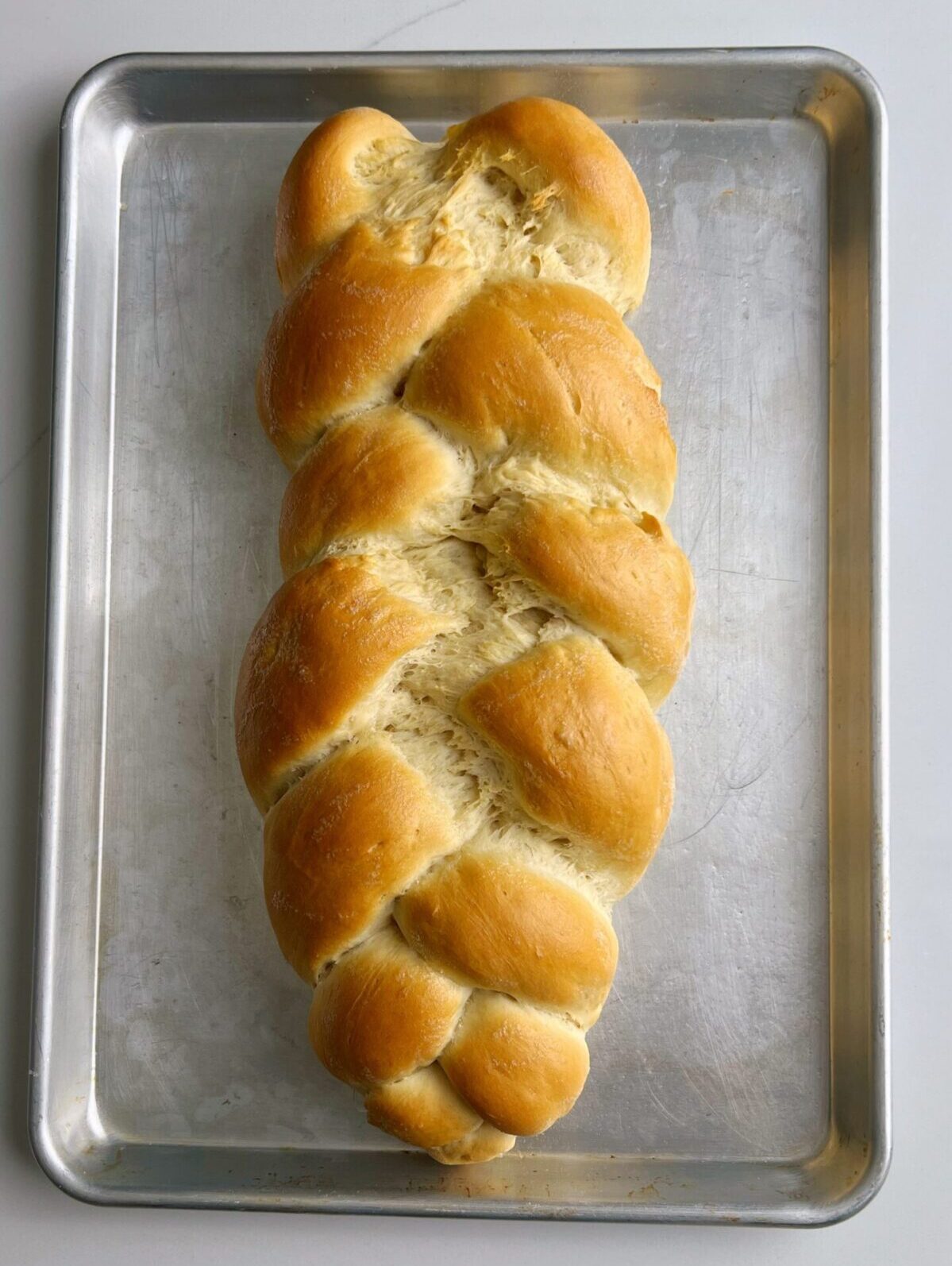

Plait Bread
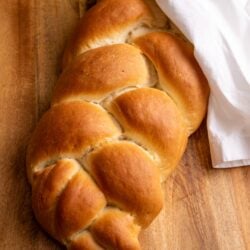
Equipment
- Whisk
- Rubber Spatula
- Mixing Bowl
- Baking Sheet
Ingredients
- 1 1/4 cup warm water (110 °F)
- 1/4 cup brown sugar
- 1 tablespoon dry active yeast
- 3 1/2 cup all purpose flour (plus more for dusting)
- 1/4 teaspoon salt
- 1/4 cup room temperature butter (plus 1 tablespoon for basting after baking)
Instructions
- In a small bowl combine the warm water and sugar. Mix until the sugar dissolves, then add the yeast and give it a stir. Cover with a towel and set aside in a warm place to bloom.
- In a large mixing bowl, combine the flour and salt and mix well. Then using a fork or your fingers mix the butter into the flour until the mixture looks crumbly.
- Next, form a well in the center of the flour and butter mixture then add the bloomed yeast. Using a whisk mix together to slowly form a pancake batter consistency, this is best achieved using a whisk. Then use your hands or a rubber spatula to pull the rest of the flour into the mixture to form a soft dough ball.
- Turn the dough onto a floured surface and knead for 5 minutes into a smooth ball or until the dough bounces back when pressed with a finger.
- Place the dough ball into a greased bowl, cover with a towel and allow to rise until it doubles in size. This takes about 45 minutes to 1 hour.
- When the dough doubles in size, punch down and knead again into a smooth ball. Then if adding the topper to the bread, cut a 2 inch piece of dough off from the ball and set aside.
- Divide the remaining dough into 3 equal parts. Tuck the cut ends of each piece of dough into the bottom (see photos above) and roll into long logs about 12 to 15 inches long.
- Next starting in the middle, braid the three pieces into a braid by going right over to center, then left over to center (step by step images are in the write up above). Go all the way to the end and tuck the ends into the bottom.
- Then flip the loaf over bringing the open ends to you and repeat the steps for braiding the open end. Then tuck the ends into the top. If this is confusing following the images under the section on "How to braid Plait Bread" above.
- If using the topper, roll the 2 inch piece of dough that was set aside earlier into a long strip, place the strip on top of the braided loaf tucking the ends under the loaf, then place the loaf on a greased baking sheet. Cover and let rise for at least an hour at room temperature.
- When ready to bake Preheat oven to 350 °F. Add the bread to the middle shelf of the oven and bake for 25 minutes or until it is golden brown. Remove from the oven and brush with 1 tablespoon of butter, move to a cooling rack and cover with a clean kitchen towel.
Notes
- To speed up the dough rising process, place covered dough in a warm oven (turn oven on to 200°F for 10 minutes, then shut it off). This is great to speed up the first proof, but should not be used for the second proof or your plait will rip apart.
- For best results let the second proof happen at room temperature and let it proof for the full hour.
- After my bread cools I place it into a bread bag to keep it fresh. If you don’t have a bread bag you can wrap it with a clean kitchen towel to keep it from drying out.
- To make Guyanese Aniseed bread 1 teaspoon of anise seeds to 1 1/4 cups of boiling water and allow to sit until the water cools down (about 110°F). Then follow the steps for making plait bread dough, using this water to bloom the yeast.
Nutrition
The information listed in the recipe card is an estimate provided by an online nutrition tool. The tool evaluates ingredient names and amounts then makes calculations based on the number of servings listed for the recipe. It is provided as a general guideline and not as a precise calculation. For precise nutrition information please feel free to add the ingredients to your preferred nutrition calculator or consult a doctor or licensed nutritionist.


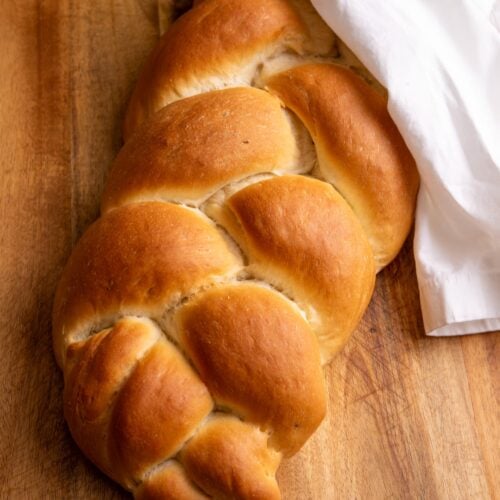

 Non-alcoholic Guyanese Black Cake
Non-alcoholic Guyanese Black Cake Pumpkin Flan
Pumpkin Flan Almond Flour Black Cake
Almond Flour Black Cake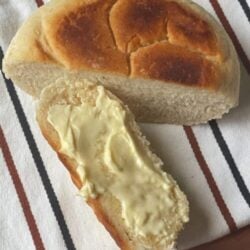 Gluten Free Pot Bread
Gluten Free Pot Bread
Alex Says
I hate making bread. I am very bad at it. But I followed the instructions along with the video and this loaf turned out PERFECTLY. So much appreciation for the honesty and transparency in her banter.
It’s springtime now where I live, but I don’t give a fl*pping f*rt — I will be making pepper pot very soon to go with my next loaf.
Erin Says
This is a wonderful recipe. I tried it and it tastes great!
Mohamed Yusuff Says
Awesome recipe!! Spot on instructions! Awesome results! Delicious and great texture. Nuff said.
Daunette OKOROH Says
I haven’t made bread in awhile so I decided to look at some recipes on YouTube this is the one I use. Very simple. Thank you.
Colette Says
This recipe was easy to follow. I also appreciated the tutorial on how to plait the bread. This was my first time making plait bread and it came out moist and it’s delicious. It wasn’t as intimidating as I expected. We had it with pepperpot and finished the last of it today – with salmon. I will definitely make it again.
Althea Brown Says
I love this. Thank you.
Gigi Says
This recipe is so easy and perfect. I made this bread for the first time with this recipe and received plenty of compliments. My niece told me this recipe tastes like something her grandmother made! That’s major kudos. After my first attempt being successful I decided to make this bread a few more times but this time let the bread sit over night. It turned out perfect once again
Dell Says
Tried this recipe for the first time and my bread came out perfect. The provided steps were very clear and detailed. Everyone loved it on so much Christmas day, I had to make another loaf on Boxing day.
Sushma Says
Tried this for Christmas and it was well received! So easy to follow and most of all delicious. My family has already requested more for new years day.
Priya Says
Thank you so very much for this amazing recipe! I followed it exactly & my Christmas Day bread came out perfectly ❤️❤️ I love all your recipes. Thanks again ☺️
Annie Saffie Says
The best recipe always!!!
Vanessa Chambers Says
I made this for the first time this year and LOVED it! The softest dough turned into such a fluffy loaf! The only thing I changed when I made it a second time was the sugar and salt. Without it, the bread lacks a bit of the flavour I’m used to BUT that didn’t make it bad, just different. Instead I added a 1/2c of the brown sugar (instead of 1/4c) and a tsp of the salt (instead of the 1/2tsp) and it was PERFECT!
Fizal Says
Great recipe overall, and laid out well. Also brings back memories of my childhood. Thank you Althea.
Michelle Says
Delicious.
Tee Says
I absolutely love this recipe. This was the 1st time I’ve attempted to bake bread and it was a hit. My mom loved it so much she ate an entire loaf by herself. Also, my Jamaican mother-in-law said it was so good I can bake some for her. She’s a tough critic and I’m happy she loved it!!! From one Guyanese to another thank you, I truly appreciate it.